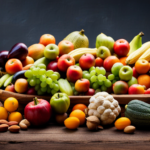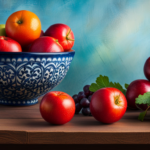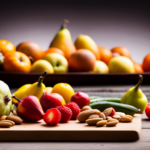Transitioning to a Raw Food Diet
What Does The Raw Food Diet Claim To Do

Hey everyone! I am a writer who specializes in nutrition, and today, I am diving into the subject of the raw food diet. This diet has been gaining popularity lately, which piqued my curiosity to look into its claimed benefits. It is important for us to thoroughly research any diet that promises better health before making the decision to follow it.
So let’s dive into our exploration of the raw food diet – what does it claim to do?
The term ‘raw food’ refers to foods that are uncooked or unprocessed and kept below 118°F (48°C). This means that fruits, vegetables, nuts, seeds and sprouted grains are mainstays on this type of diet.
But how does eating these types of foods benefit us? That’s what we’ll explore next.
Benefits Of Eating Raw Foods
Eating raw foods has been gaining popularity in recent years, and with good reason. The practice of eating raw food is rooted in ancient history, but its potential benefits for modern-day health are still being explored. Could it be that consuming food before it’s cooked or processed could be beneficial to our well-being?
Let’s take a closer look at the advantages of eating raw.
The key to successfully incorporating raw preparation into your diet lies in taking the time to understand how different ingredients interact with one another. Knowing what type of combinations work best when preparing a meal can help ensure you’re getting maximum nutritional value out of each dish. Additionally, making sure you have all your necessary equipment on hand – like blenders and dehydrators – will make creating flavorful recipes easier than ever!
Raw food diets also emphasize mindful eating and portion control; however, this doesn’t necessarily mean cutting back on calories. Instead, focusing on nourishing whole foods encourages us to savor flavors while giving our bodies the nutrients they need without overindulging. With careful planning and diligent attention to proper food combining, a healthy balance between indulgence and nutrition can easily be achieved through an enjoyable dining experience.
Advantages Of A Raw Food Diet
The advantages of a raw food diet are undeniable. Eating foods in their natural state and consuming fresh fruits, vegetables, nuts, seeds, legumes and grains is an easy way to reduce your intake of processed ingredients and increase overall nutrition.
Not only does it provide high quality vitamins and minerals from unrefined sources, but it also helps limit the amount of added sugar that can be found in many cooked dishes.
Raw preparation techniques such as blending, juicing or dehydrating offer plenty of variety when including uncooked foods into your meals. As well as being incredibly tasty, these methods retain all essential nutrients provided by raw foods without having to resort to cooking them.
Additionally, enjoying meals at room temperature allows for better digestion and absorption of vital nutrients.
This type of diet offers multiple benefits ranging from improved energy levels to weight management while avoiding any artificial flavors or additives. It’s important to note though that this approach requires careful planning so you don’t miss out on certain key vitamins and minerals like calcium which may not be available with a purely raw food diet.
With some tweaks here and there however, you can enjoy the best of both worlds while reaping all its nutritional rewards! Essential nutrients provided by raw foods can help boost immunity, support healthy aging and generally make us feel good inside-out.
Essential Nutrients Provided By Raw Foods
Many people worry that the raw food diet won’t provide them with enough essential nutrients. But there are actually an abundance of nutrient sources available on a raw diet, with more variety than you may think! From fresh fruits and vegetables to nuts, seeds, sprouts, seaweeds and fermented foods – all these offer key vitamins and minerals in their purest form.
On top of this, cooking methods can be used to make some meals even healthier by making it easier for your body to absorb certain nutrients. For instance, soaking grains and legumes before eating helps break down phytic acid which otherwise blocks important minerals from being absorbed into the body. Similarly, blending or juicing fruits and veggies can help unlock powerful antioxidants normally locked away inside cell walls. Even lightly steaming greens like spinach helps increase the absorption of iron content found within them.
No matter how you prepare your meal though, what matters most is enjoying it! Be sure to fill up on plenty of leafy greens as they contain high amounts of calcium and magnesium – both vital for strong bones and teeth. Eating dishes packed full of colorful produce also adds flavor while giving your skin a healthy glow due to its abundance of vitamins A & C.
Eating Tips For The Raw Food Diet
Eating raw is a great way to enjoy the natural flavors of food while benefiting from its nutrients. There are several different styles of eating on the Raw Food Diet, depending on your preferences and food availability. Taking into account all these factors can make it easier to stick with the diet in the long run.
Here are some tips for getting started:
-
Planning ahead: Before you shop or prepare meals, take time to plan out your weekly menu so that you have enough variety and nutrition throughout the week. This will also help ensure that you don’t become bored with the same foods day after day.
-
Learning about food preparation techniques: Knowing how to properly clean, chop, blend and store fruits and vegetables is key when preparing raw dishes. Researching recipes online or taking cooking classes may be helpful in learning more about food prep techniques.
-
Experimenting with new ingredients: Trying out new ingredients can keep things interesting and give yourself plenty of options for tasty combinations. Be sure to research any potential health benefits associated with certain types of produce before adding them to your diet as well.
With this knowledge under your belt, you’ll be able to incorporate delicious raw dishes into your meal plans without feeling overwhelmed by unfamiliarity or lack of resources.
To sum up, there are many ways that one can successfully transition onto a raw food diet; planning ahead, learning food preparation techniques and experimenting with new ingredients can all help make this process easier and enjoyable!
Now let’s move onto looking at some disadvantages of eating raw foods…
Disadvantages Of Eating Raw Foods
The raw food diet has a great allure, but it can also come with some drawbacks. Eating primarily uncooked foods may seem like the perfect way to eat healthily and stay energized, yet many don’t realize that there are certain risks associated with this type of eating plan.
For starters, storing large amounts of raw produce or other ingredients can be difficult in a kitchen without proper storage space. Without adequate refrigerator space for fruits, vegetables, nuts and seeds, they will often spoil quickly if not properly stored. This means having to go grocery shopping more frequently than someone who is on a typical cooked-foods diet.
Additionally, many processed foods contain preservatives which help them last longer; something you would never find in a completely raw diet. What’s more, this style of nutrition is often accompanied by dietary restrictions and limitations since many people restrict their diets even further when following the principles of a raw food lifestyle.
Although these restrictions have been known to provide miraculous results for some people – such as weight loss or improved digestion – others struggle to find enough variety from day to day due to their chosen level of restriction. With so much focus on one particular style of eating over time; it could lead to missing out on essential vitamins and minerals found in different types of cuisine outside the realm of raw veganism.
As we consider these disadvantages, it’s important to remember the power behind making conscious decisions about what we put into our bodies each day: whether cooked or uncooked! We must always keep an open mind while exploring new ways of nourishing ourselves through mindful meal choices – no matter how extreme they may appear at first glance.
Common Misconceptions About The Raw Food Diet
Despite the many benefits of eating raw foods, it still has its disadvantages as well. Many people are unaware of these aspects and often have misconceptions about what a raw food diet involves. Here we will discuss some of the more common misunderstandings of this lifestyle choice.
Raw substitutes are one of the biggest sources of confusion when it comes to following a raw food diet. It is important to remember that while processed products like vegan ice cream or mock meats can be made using completely natural ingredients, they should not be considered replacements for fresh produce in your daily meals. A true raw food diet requires real fruits and vegetables as part of every meal.
Additionally, many people misconstrue the amount of effort required for such an extreme lifestyle change. While there may be additional preparatory steps involved with preparing certain dishes, such as soaking nuts overnight or dehydrating fruit slices, much less time and energy than cooking is actually needed to follow a successful raw food regimen.
Making small adjustments to your current menu choices over time can make transitioning easier, so don’t be overwhelmed!
In addition to understanding which items are allowed on the diet and how much extra preparation is involved, you must also take into account any potential health risks associated with a high-raw menu plan—such as vitamin deficiencies if you’re relying too heavily on plant-based proteins instead of animal sources. Consider meeting with a nutritionist before making significant changes to ensure that you get all the nutrients you need without sacrificing taste or convenience.
Benefits Of Juicing On The Raw Food Diet
Jumping on the raw food bandwagon has become popular in recent years, and for good reason. One of the primary ways to nourish your body with raw nutrition is through juicing, which provides a powerhouse punch of vitamins, minerals, and other nutrients that can be difficult to get from cooked foods.
Let’s take a look at some beneficial effects of juicing when following a raw food diet.
To start off with, one of the major benefits of juicing lies in its convenience – you can pack an entire day’s worth of produce into one glass without having to spend hours preparing meals or snacks. Plus, since most fruits and vegetables are naturally high in water content and low in calories, they provide plenty of hydration while helping manage weight gain. This makes it easier than ever to enjoy all those nutritious goodies without any extra effort!
At the same time, consuming fresh juices helps the body absorb more nutrients than if we were eating whole veggies alone. The fiber contained within many fruits and vegetables acts as a barrier between us and their valuable compounds; however, once they are liquified these compounds become readily available for absorption by our cells.
Additionally, drinking freshly made juices can also help reduce inflammation throughout the body due to their anti-inflammatory properties.
Juicing offers numerous health benefits for anyone looking to switch up their diet routine – but how does it fit into a long-term lifestyle? We’ll dive deeper into this question next as we explore potential health risks associated with eating raw foods.
Potential Health Risks Of Eating Raw Foods
While a raw food diet offers many great benefits, it is important to understand the potential health risks associated with eating uncooked and often unprocessed foods. It is essential that anyone considering a raw food diet take into account both the safety of consuming such a diet as well as its proper preparation.
The most significant risk associated with eating raw foods lies in their possible contamination by bacteria and germs such as salmonella, E. coli, or listeria. While these pathogens can be killed through cooking and pasteurization, they may remain on fruits and vegetables if they are improperly washed or handled before consumption. To reduce the risk of foodborne illness when following a raw food diet, choose organic produce whenever possible and always wash your hands and all products thoroughly before preparing them for consumption. Additionally, avoid unpasteurized dairy products like cheese and cream which could contain harmful bacteria that cannot be destroyed by hand-washing alone.
Another concern when transitioning to a raw food diet is ensuring proper nutrition since some vitamins found naturally in certain foods are only available once heated above 118 degrees Fahrenheit. Vegetarians should pay special attention to getting adequate amounts of iron from leafy greens like spinach; B12 from fortified plant milks; vitamin D from mushrooms exposed to sunlight; calcium from sesame seeds; omega-3s from chia seeds; zinc from beans; and iodine from sea vegetables like seaweed nori sheets.
By taking care to diversify one’s intake across multiple sources, individuals can ensure adequate nutrient levels while still enjoying the numerous benefits of consuming mostly raw foods.
Potential Nutritional Deficiencies On The Raw Food Diet
I’m a big believer in the raw food diet, but I’m concerned about the potential nutritional deficiencies it can lead to.
There’s the lack of vitamins that come with the raw food diet, which can cause serious health issues.
Protein intake is also a concern, as it’s difficult to get the adequate amount of protein without cooked foods.
Lastly, calcium deficiency is something to be mindful of, as it’s hard to get enough calcium without eating dairy or cooked foods.
All of this can lead to serious health issues if not properly managed.
That’s why it’s important to be mindful of these potential nutritional deficiencies when considering the raw food diet.
Lack Of Vitamins
When it comes to eating habits, many people are turning to raw food diets in order to get healthier. Unfortunately, the lack of vitamins found in this diet could lead to nutritional deficiencies down the line.
For starters, cooking certain foods can actually increase their vitamin content and make them easier for our bodies to absorb; with a raw food diet, you miss out on that process. Many essential vitamins like B12 and D aren’t naturally present in many fruits and vegetables, so if these staples make up your only source of nutrition, you may be missing out on key nutrients.
Even when consuming fortified plant-based alternatives such as soy milk or almond butter, they still do not contain all the same vitamins as animal sources which are often excluded from a raw food diet. To ensure adequate intake of these important micronutrients it is best to look into supplementing your diet with multivitamins or adding in some cooked meals during the week!
Low Protein Intake
Another potential deficiency found on the raw food diet is protein. Protein is essential for all sorts of bodily functions, such as muscle growth and repair.
While some fruits and vegetables do contain small amounts of protein, they are simply not enough to meet your daily needs. Additionally, high temperature cooking can denature proteins which can render them less absorbable by our bodies.
This means that even if you were consuming cooked vegan sources like tofu or tempeh, it may still be difficult to get adequate levels from plant-based products alone without adding in other animal sources such as eggs or fish; although these foods must also be handled safely when preparing them.
Therefore, it is important to ensure that you’re getting enough protein in your diet no matter what kind of eating habits you follow!
Calcium Deficiency
Another potential deficiency found on the raw food diet is calcium. Calcium is necessary for bone health and other bodily functions, such as digestion.
Unfortunately, many fruits and vegetables do not provide an adequate amount of this important mineral. Additionally, high-temperature cooking can actually destroy some of the available calcium – making it difficult to get enough from plant-based sources alone.
This means that if you are following a strict raw food diet, you will need to supplement your intake with dairy products or other fortified foods in order to meet your daily needs. Furthermore, consuming plenty of leafy greens like kale and spinach may also help boost calcium levels while providing additional vitamins and minerals too!
Vegan And Vegetarian Options On The Raw Food Diet
Vegan and vegetarian options on the raw food diet offer a great way to get many of the benefits associated with this lifestyle. Plant-based proteins make up an important part of the diet, providing essential nutrients while also helping you maintain your energy levels throughout the day. Additionally, you can enjoy delicious raw desserts without sacrificing any of its nutritional value – no baking or heating required!
| Proteins | Fruits/Vegetables | Desserts |
|---|---|---|
| Nuts & Seeds | Leafy greens | Raw cakes & Pies |
| Legumes | Berries | Fruit sorbets |
| Tempeh | Citrus fruits | Chocolate truffles |
Eating vegan or vegetarian meals according to the principles of a raw food diet is not only nutritious but it also helps promote environmental sustainability. For example, plant-based proteins require less resources than animal products in terms of land use, water consumption and carbon emissions. Plus, these foods are often more affordable than their cooked counterparts since they do not involve lengthy cooking processes or expensive ingredients.
With all these advantages, it’s easy to see why so many people choose to transition to a raw food diet. Not only will you be able to reap the health rewards associated with eating unprocessed foods, but you’ll also be taking care of your planet too!
Tips For Transitioning To The Raw Food Diet
Making the transition to a raw food diet can be daunting, but it doesn’t have to be. Think of it like taking your first dip in a cool pool on a hot day – once you jump in and get comfortable with the temperature, you won’t want to leave!
With that in mind, here are some tips for making this transition as smooth and enjoyable as possible.
When transitioning to a raw food diet, snacks are key. Instead of reaching for processed options or unhealthy treats, try stocking up on fresh fruits and vegetables that meet your nutrition goals. Carrots and celery make great crunchy snacks when dipped into hummus or guacamole, while applesauce is yummy eaten straight out of the jar. Nuts are also an excellent source of protein and healthy fats that will keep you full throughout the day.
Raw cooking techniques may seem intimidating at first glance, but they don’t have to be complicated. To start off slowly, experiment with simple recipes like salads and fruit bowls which require no heat whatsoever. You can even use pre-cut ingredients from your local grocery store if time is limited. As you become more comfortable with raw cooking methods such as blending and dehydrating, incorporate them into your meals too – there’s no limit on how creative you can get!
By following these simple tips, transitioning to a raw food diet should feel achievable rather than overwhelming. Remember: take it one step (or bite!) at a time until you find what works best for your lifestyle.
Sample Meal Plan For The Raw Food Diet
I’ve been following the raw food diet for some time now and I can confidently say that it has truly made a difference in my life. Eating unprocessed, uncooked foods provides your body with essential nutrients and vitamins so you feel energized throughout the day. And since you’re preparing meals from scratch using fresh ingredients, it helps to develop healthy eating habits as well.
So what does a typical meal plan on the raw food diet look like?
Well, breakfast could be something like an omelet made of coconut meat and veggies or a smoothie bowl topped with bananas and chia seeds.
Lunch might include a colorful salad loaded with nuts, seeds, sprouts and avocado while dinner could be zucchini noodles sautéed in garlic-infused olive oil.
Snacks such as energy balls and dehydrated fruit may be enjoyed between meals as well!
These are just some examples of how to incorporate raw ingredients into your daily routine but there are loads of other ways to get creative too! Ideas for healthy and delicious raw food recipes abound online – why not try one out today?
Ideas For Healthy And Delicious Raw Food Recipes
Eating raw food is like a breath of fresh air for your body; it’s nourishing, energizing and full of life. If you’re looking to make the switch to a more nutrient-dense diet, there are so many delicious and healthy recipes out there that will help you hit your health goals.
Here are some quick snack ideas to get you started:
-
Fruits & Veggies:
-
Try cutting up bell peppers or carrots with hummus as a dip.
-
Make smoothies with frozen fruits or vegetables with almond milk and collagen powder for an added protein boost.
-
Nuts & Seeds:
-
Create trail mix by combining nuts, seeds, dried fruit, dark chocolate chips, and coconut flakes.
-
Sprinkle chia seeds on top of yogurt for an extra crunchy texture.
No matter what kind of snack you choose to make, adding in those raw foods can be incredibly beneficial for overall health and wellness; from increased energy levels during the day to better digestion at night!
Supplements To Consider On The Raw Food Diet
The raw food diet has become increasingly popular in recent years as a way to optimize health. It involves consuming mostly unprocessed and uncooked foods, with an emphasis on fruits, vegetables, nuts and seeds.
While the raw food diet can be beneficial for some people, it is important to consider supplementing your diet with certain products that may not be available from raw sources. Raw milk and sprouted grains are two such supplements that can help round out your nutrition plan if you’re following the raw food approach.
Raw milk offers plenty of vitamins and minerals like calcium, magnesium and potassium. Plus, it contains probiotics which can aid digestion and boost immunity.
Sprouted grains provide additional fiber while also delivering essential nutrients like Vitamin C and zinc. Both of these dietary additions are ideal for any individual looking to maximize their nutrient intake on a raw food diet but who don’t have access to all the necessary produce or other items needed.
When incorporating supplements into your meal plans, always remember to check labels carefully so that you know exactly what you’re putting into your body. Additionally, make sure to consult with a healthcare professional before making any major changes to your diet or lifestyle routine.
With careful consideration of nutritional needs, adding supplements such as raw milk or sprouted grains can give extra support when transitioning away from cooked meals towards eating more fresh produce-based dishes. Moving forward, let’s explore alternative approaches one might take instead of sticking strictly to the guidelines set by the raw food diet itself.
Alternatives To The Raw Food Diet
Having discussed the supplements to consider on the raw food diet, it’s time to look at alternatives. Though some may be tempted to think that this type of eating is restrictive, there are actually plenty of options available if you want to take a break from consuming only raw ingredients and snacks.
Here’s what else you can do:
-
Increase your intake of cooked vegetables – Cooked vegetables can add variety to your meals without having to give up on the benefits of going raw. Plus, they’re easy to prepare and often require minimal effort. Try adding roasted peppers or grilled mushrooms for extra flavor!
-
Experiment with vegan recipes – Going vegan isn’t just about avoiding animal products; it can also mean exploring new flavors and textures. There are many delicious vegan dishes out there made from nutritious plant-based ingredients like beans, nuts, seeds, and grains. Give them a try!
-
Make smoothies – Smoothies make great breakfast or snack options when following a raw food diet. Use fresh fruits, veggies, nut butters, superfoods like chia seeds or spirulina powder—whatever you have in the fridge will work perfectly! They’ll provide essential vitamins and minerals while being tasty as well.
While these alternatives might not offer all the same benefits as sticking strictly to a raw foods diet, they still provide ample amounts of nutrients whilst giving your body a much needed change in texture and taste.
Whether you’re looking for something familiar yet different or something totally unfamiliar – either way – experimenting with these ideas could be an exciting journey into discovering healthier ways of eating!
Frequently Asked Questions
What Is The Recommended Daily Caloric Intake On The Raw Food Diet?
Eating a raw food diet is like taking the scenic route to health and wellness.
There are no hard-and-fast rules on how many calories you should eat per day, but it’s typically recommended that adults consume anywhere from 1,200 to 2,400 calories or more each day depending on your eating habits and meal planning.
A raw food diet is based on consuming uncooked plant foods such as fruits, vegetables, nuts and seeds as well as some fermented items like sauerkraut and kimchi.
Those following this type of diet will get most of their nutrients in liquid form through juices or smoothies.
Can The Raw Food Diet Be Followed While Eating Out?
The raw food diet can be followed while eating out, but it does require some extra caution and awareness.
Eating at social gatherings or outside of the home can make it difficult to maintain a strict raw food diet since many restaurant dishes contain cooked ingredients.
To successfully follow a raw food diet while eating outdoors, you should choose restaurants that specialize in serving uncooked meals like salads, smoothies and juices.
Additionally, look for items on the menu which are made with fresh fruits and vegetables instead of processed options.
If possible, avoid deep-fried foods as well as any type of fast food.
With a bit of planning and effort, it is certainly possible to enjoy your time away from home without compromising your commitment to the raw food diet.
Are There Any Special Considerations For Children On The Raw Food Diet?
When it comes to children and the raw food diet, there are several special considerations.
Plant-based nutrition is especially important as growing bodies need a variety of nutrients in order to develop properly.
Dehydrated snacks like trail mix can be great for kids who want something more than just fruits and vegetables.
It’s also essential that parents ensure their child is getting adequate calories and protein by supplementing with nuts, seeds, nut butters, or other plant-based proteins if necessary.
What Is The Cost Of Following The Raw Food Diet?
Following a raw food diet doesn’t have to be expensive. In fact, many budget-conscious eaters opt for this style of eating since it typically involves fewer processed foods and can focus on whole, unprocessed ingredients that are relatively inexpensive.
Eating out while following the raw food diet is possible too – just make sure you’re aware of your options beforehand and ask questions when necessary.
With careful planning and smart shopping habits, you can easily stay within your budget while still meeting all your nutritional needs.
How Long Does It Typically Take To See The Health Benefits Of The Raw Food Diet?
If you’re looking for a dietary overhaul that could drastically change your life, then the raw food diet is definitely worth considering.
But how long does it typically take to see health benefits from this extreme eating plan?
Well, unbelievably fast!
With just some minor changes in your eating habits and dietary choices, many people report feeling better within days – even if they haven’t lost any weight yet.
And with continued dedication to the raw food lifestyle, their bodies start to show remarkable improvements almost immediately.
So don’t wait another minute; try the raw food diet today and experience its amazing effects yourself!
How Does the Barf Raw Diet Compare to the Traditional Raw Food Diet?
The barf raw diet concept explanation highlights the difference between the Barf Raw Diet and the Traditional Raw Food Diet. While the Traditional Raw Food Diet focuses on meat, fruits, and vegetables, the Barf Raw Diet incorporates bones and raw food for a more balanced approach to pet nutrition.
Conclusion
The Raw Food Diet has been gaining popularity as an effective way to lose weight, gain energy and improve overall health.
While transitioning to a raw food diet can be challenging, the long-term benefits are worth it.
In fact, research suggests that on average people who follow the Raw Food Diet for at least three weeks experience improved digestion, increased energy levels and up to 10 pounds of weight loss in just one month!
It’s no wonder why so many people are embracing this lifestyle change – if you want to feel your best and enjoy lasting results, give the Raw Food Diet a try.
With its encouraging results and delicious recipes, you’ll find yourself feeling healthier than ever before.
Lorraine, a talented writer for rachaelsrawfood.com, brings a unique blend of creativity and expertise to the platform. With her passion for writing and deep knowledge of raw food, she plays a crucial role in inspiring and educating readers about the joys and benefits of a raw food lifestyle.
Lorraine’s creativity shines through in her recipe development. She enjoys experimenting with unique flavor combinations and innovative cooking techniques, pushing the boundaries of what can be achieved with raw ingredients. Her recipes not only showcase the incredible taste and variety of raw food but also demonstrate that a raw food diet can be exciting, diverse, and satisfying.
In addition to her writing contributions, Lorraine actively seeks out new trends, research, and developments in the field of raw food. She attends workshops, conferences, and culinary events, constantly expanding her knowledge and staying up to date with the latest discoveries. This commitment to continuous learning ensures that her writing remains current, reliable, and relevant to the ever-evolving landscape of raw food.
Lorraine’s genuine enthusiasm for raw food is contagious, and she strives to connect with readers personally. She understands that embracing a raw food lifestyle can be a journey, and she uses her writing to provide guidance, support, and encouragement to individuals at all stages of their journeys. Her empathetic approach and storytelling make her a trusted and relatable voice in the raw food community.
Transitioning to a Raw Food Diet
How Raw Vegan Diet

Hello! I am well-versed in the raw vegan lifestyle, and I am thrilled to discuss the incredible benefits of transitioning to a raw diet.
A raw vegan diet is one that consists solely of plant-based foods like fruits, vegetables, nuts, and seeds – as well as sprouted grains – that are never cooked or heated above 115 degrees Fahrenheit. This way of eating can provide numerous health benefits, including improved digestion, better nutrient absorption and higher energy levels.
In this article, I’ll be discussing how raw veganism can help improve your overall wellbeing. So keep reading if you’re interested in learning more about the advantages of this lifestyle change!
What Is A Raw Vegan Diet?
Eating a raw vegan diet is like traveling to culinary paradise! From the crunchy freshness of veggies and fruits to the creamy richness of nut-based dishes, there’s no shortage of delicious meal options.
As an expert in this field, I can safely say that transitioning from processed foods to whole plant-based meals can be life changing – not only for your taste buds but also for your health.
Raw recipes provide us with all the vitamins, minerals, antioxidants, and healthy fats we need without compromising on flavor or texture. Eating habits focused on consuming unprocessed plant-based ingredients help restore balance within our bodies and create a sense of well being unlike any other food lifestyle out there.
The beauty of eating raw foods lies in its simplicity – you don’t have to spend hours slaving away in the kitchen just to enjoy a nutritious meal. All it takes is some basic knowledge about nutrition combined with creativity and access to quality ingredients. Plus, as you start exploring more options, you’ll soon find yourself spoilt for choice when it comes to deciding what delicious dish you should prepare next!
Moving ahead onto benefits of eating raw foods…
Benefits Of Eating Raw Foods
I’m a big believer in the power of a raw vegan diet for improving overall health and wellbeing.
One of the main benefits I’ve seen is improved digestion. Eating raw, unprocessed foods can help keep the gut functioning properly, reducing symptoms such as bloating and gas.
Along with improved digestion, people often notice increased energy when they switch to a raw diet. All the nutrients in raw foods, like fruits and vegetables, give us sustained energy throughout the day.
Plus, you’ll be getting enhanced nutrition. Raw foods retain all their vitamins and minerals, giving us a nutrient-dense diet that’s good for our bodies.
Improved Digestion
As a raw vegan diet expert, I know how important digestion is when it comes to health and wellbeing. Eating raw foods can improve your digestive system in multiple ways:
firstly, because most of the food you eat is uncooked, less energy needs to be used for digestion;
secondly, raw snacks are often full of natural enzymes that help break down macronutrients more effectively than cooked meals;
finally, you will be consuming more fibrous vegetables and fruits which helps keep the gastrointestinal tract healthy and functioning.
A vegan lifestyle that includes plenty of fresh produce can provide major benefits for your gut bacteria – this improved microflora balance leads to better nutrient absorption so you get the maximum nutritional content out of each meal.
Many people also find they feel lighter after switching to eating mostly or all raw foods because their body isn’t having to work as hard at breaking down large amounts of cooked proteins or starches.
The dietary changes associated with going raw have been proven time and again to bring about quick improvements in overall health – from increased energy levels to clearer skin and fewer digestive issues such as gas or bloating.
So if you’re looking for an easy way to look and feel healthier without making huge changes, consider incorporating some delicious raw snacks into your daily routine!
Increased Energy
One of the most noticeable benefits of eating raw foods is increased energy.
Raw plant based proteins provide your body with all the essential amino acids it needs to function at its best – and because these are natural sources, they don’t come with any artificial additives that can weigh you down.
On top of this, raw nutrition contains fewer calories than cooked food so you get more bang for your buck when it comes to sustaining energy levels throughout the day.
Plus, consuming fibrous vegetables helps promote intestinal motility which in turn keeps blood sugar balanced and ensures constant energy supply!
At first transitioning to a mostly or completely raw vegan diet may seem overwhelming but trust me – once you start seeing results such as improved digestion, clearer skin and increased energy levels, you’ll be glad you made the switch!
Eating fresh produce also provides an abundance of vitamins and minerals that have been proven time and again to improve overall health without relying on processed foods.
So why not give it a try? You won’t regret it!
Enhanced Nutrition
The nutrition benefits of eating raw foods are undeniable.
By consuming plant based proteins and getting your daily dose of vitamins and minerals from fresh produce, you’re giving your body the fuel it needs to perform optimally.
Not only that but because raw snacks require very little cooking or processing, they also tend to retain more nutritional value than their cooked counterparts!
And with fewer calories per serving too – what’s not to love?
If you want to get the most out of a raw vegan diet then make sure you incorporate plenty of fresh fruit and vegetables into every meal.
Eating lots of greens can help ensure vital nutrients like iron and calcium are present in your diet – key elements for healthy blood cells, bones and overall energy levels.
Raw food doesn’t have to be boring either – why not try experimenting with different recipes or creating fun smoothie bowls by adding seeds and nuts on top?
With so many delicious options available there’s something for everyone – so don’t hesitate to give this lifestyle a go today!
Digestive Benefits Of Going Raw
Going raw can provide some serious digestive benefits. First and foremost, it has the potential to dramatically increase nutrient density in your diet. This is because many of the processed foods we consume are lacking essential vitamins, minerals and other nutritious elements that our bodies need for optimal health. By opting for a raw vegan diet you can be sure that you’re getting all the nutrients that nature intended us to have.
Another advantage of going raw is its ability to help maintain an alkaline balance within the body. When we eat overly-processed or sugary foods it throws off this balance which can lead to numerous health issues such as fatigue, headaches and acid reflux. Eating more fruits and veggies helps keep everything in check by providing a great source of alkalinity which keeps our digestion running smoothly.
In addition to improved nutrient density and balanced pH levels, eating a mostly plant-based diet also encourages healthy digestion habits like chewing food thoroughly before swallowing which helps stimulate proper enzyme production and break down food into smaller particles so they can be absorbed better by your body’s cells.
All of these factors combined make switching to a raw vegan lifestyle worthwhile if you’re looking for healthier, long lasting digestive benefits. Nutrient absorption is key when it comes to maintaining good gut health since what we absorb from our diets plays an important role in how well our bodies function overall.
Nutrient Absorption
When it comes to a raw vegan diet, nutrient absorption is key. Raw foods are composed of enzymes that our bodies need for optimal digestion and nourishment. These enzymes remain intact when foods are in their most natural state, so eating them raw helps us absorb the vitamins and minerals from plants more efficiently.
Plant proteins provide essential amino acids which help build muscle tissue – all without the saturated fats found in animal products. It’s important to note that many cooked plant-based meals can still be healthy as long as they aren’t loaded with unhealthy additives or processed ingredients.
Eating some cooked plant proteins like beans and legumes alongside plenty of fresh, raw fruits and vegetables will ensure you’re getting an adequate amount of nutrients each day. Additionally, adding superfoods such as spirulina, chia seeds, hemp hearts and nuts into your daily routine may also benefit your health overall.
Raw food diets offer numerous benefits beyond just nutrient absorption: They can help reduce inflammation, improve energy levels and support cellular detoxification processes within the body. By consuming mostly uncooked dishes made up of whole food sources rich in antioxidants and vital compounds, you’ll give your immune system a much needed boost while providing yourself with optimal nutrition!
Cellular Detoxification
It’s estimated that as much as 70% of our bodies’ daily energy is used to digest food. That means the majority of our resources are spent just breaking down what we eat, and not on other important functions like detoxification or increased energy levels.
For those following a raw vegan diet, this number can be drastically reduced by consuming plant enzymes in their raw form and supplementing with fresh raw juices.
Raw foods naturally contain many beneficial enzymes which help break down matter more easily, making it easier for us to absorb vital nutrients without using up so much energy in digestion. This additional energy can then be put towards cellular detoxification and increasing your energy level throughout the day.
By eating living foods rich in vitamins, minerals, proteins and other essential components, you’ll enjoy all sorts of health benefits from improved mental clarity to balanced hormones and accelerated healing processes.
With such enhanced nutrition available through a raw vegan diet, transitioning away from cooked foods has never been easier! And now that you have access to these powerful nutrients, it’s time to reap the rewards by experiencing increased energy levels.
Increased Energy Levels
After detoxifying our cells, we can start to experience increased energy levels by making simple lifestyle changes.
Eating habits are key when it comes to maintaining high energy levels and feeling energized throughout the day – this is especially true if you follow a raw vegan diet.
The most important step in increasing your daily energy output is to make sure you’re getting the right nutrients from all of your meals. Incorporating plenty of fruits and vegetables into your meals ensures that you have enough vitamins and minerals to keep your body running optimally.
Additionally, adding some healthy fats like nuts or seeds can give you an extra boost as well as providing essential omega-3 fatty acids for cellular health.
Finally, leading an active lifestyle will help ensure a steady stream of energy throughout the day – even something as simple as taking regular walks during lunchtime can be helpful!
By implementing these small but impactful lifestyle choices, following a raw vegan diet becomes much easier and more enjoyable with improved mental clarity being just one of the many benefits gained along the way.
Improved Mental Clarity
From the first day of embarking on a raw vegan diet, many notice an immediate improvement in their mental clarity.
A clear mind awakens to feelings of alertness and invigoration, allowing one to think more deeply and focus with greater intensity.
An enhanced state of mental acuity is not only beneficial for the pursuit of knowledge but can also bring about better sleep and improved moods.
The effects that these benefits have on our overall wellbeing are profound; when we feel healthy mentally, it reflects positively upon our physical health too.
Hormones will be balanced, energy reserves replenished and stress levels drastically reduced.
Alongside this positive transformation comes a new found enthusiasm for life which leads us to be happier, healthier individuals inside and out!
By eating in harmony with nature’s seasonal cycles, taking regular exercise and practicing mindfulness techniques such as yoga or meditation – we begin to reap the rewards from living a raw vegan lifestyle even further.
The result? Improved mental clarity during all hours of each day brings forth healthier skin and hair – leaving you looking vibrant and feeling your best!
Healthier Skin And Hair
Making dietary changes is a great way to improve the health of your skin and hair.
Drinking plenty of water is essential to ensure your skin and hair stay hydrated.
Using natural cleansers and oils can help nourish and protect your skin and hair.
Supplements can also be beneficial for achieving healthier skin and hair, so I suggest looking into some plant-based options.
Dietary Changes
When it comes to having healthier skin and hair, one of the best things you can do is switch to a raw vegan diet. Plant-based eating has been scientifically proven to help improve the look and overall health of your complexion, as well as promote more robust locks!
By transitioning to this lifestyle, you’ll be avoiding processed foods that are full of unhealthy fats, oils and chemicals which have all been linked to dulling our complexions. Plus, by incorporating new cooking techniques such as steaming and blending into your routine, you’re also able to preserve vital vitamins and minerals found in fruits and vegetables that contribute towards glowing skin and strong hair growth.
Ultimately, if you want beautiful skin and luscious hair without resorting to harsh chemical treatments or products for results – turning to a raw vegan diet will give you just that!
Hydration
Staying properly hydrated is key to having healthier skin and hair, especially when transitioning to a raw vegan diet. A lack of water can cause your complexion to become dry and flaky while also leading to brittle strands that are more prone to breakage.
By consistently drinking plenty throughout the day – you’ll be able to keep your body functioning optimally and maintain an optimal level of moisture on the outside!
If you’re finding it difficult getting enough fluids in, then there are lots of ways to make hydrating fun such as infusing fruits like lemons or oranges into plain or sparkling water for some added flavor. You can even try making smoothies out of high-water content foods like cucumbers or melons which will help ensure proper hydration levels too.
Ultimately, by incorporating simple strategies such as these into your routine – you can easily reach your desired goal of achieving beautiful skin and luscious locks without sacrificing taste or quality nutrition from being on a raw vegan diet!
Weight Loss And Maintenance
The raw vegan diet can be an incredibly effective way to lose weight and maintain it. This is thanks to its emphasis on whole fruits and vegetables, which are naturally low in calories yet rich in nutrients.
A good exercise regimen combined with portion control will help you get the most out of your raw vegan lifestyle. Not only that, but balance is key – don’t deprive yourself by completely cutting out foods from any food group!
An important thing to note when following a raw vegan diet for weight loss or maintenance is that snacking between meals can actually be beneficial if done right. Choose healthy snacks like nuts, seeds, fruit and veggies so that you’re getting all the essential vitamins and minerals without overloading on empty calories. Remember not to go overboard – snack smartly!
By maintaining a balanced raw vegan diet while also exercising regularly and controlling portions, you’ll find yourself losing weight at a sustainable pace as well as reaping other health benefits such as reduced risk of heart disease. So keep up with those habits and you’ll soon start to see results!
Reduced Risk Of Heart Disease
Making the switch to a raw vegan diet is not only beneficial for weight loss and maintenance, it can also dramatically reduce your risk of heart disease.
By consuming a variety of plant-based proteins, antioxidants and other raw nutrition in their most natural form – you are providing your body with essential vitamins, minerals and nutrients which help keep cholesterol levels low and cardiovascular health high.
Eating this way even has the potential to reverse serious conditions like atherosclerosis or hypertension!
The key difference between eating cooked food versus uncooked foods lies in their nutritional content.
Raw produce contains more enzymes, amino acids and phytonutrients than processed meals that have been heated up or otherwise modified during preparation.
These compounds play an integral role when it comes to protecting our bodies from diseases such as coronary artery disease by preventing plaque buildup in the arteries.
Moreover, adhering to a predominantly raw vegan diet helps control inflammation throughout the body – another major factor for reducing one’s chances of developing heart problems.
Going raw vegan isn’t just about avoiding unhealthy fats; it’s about stocking your kitchen with nutrient dense ingredients that will aid in keeping your heart healthy long term.
And while there may be some growing pains along the way – especially if you’re used to cooking all of your meals – taking advantage of what nature provides us with can prove invaluable when looking out for our hearts’ best interests.
Reduced Risk Of Diabetes
Switching to a raw vegan diet can help reduce the risk of diabetes. Blood sugar, insulin levels, and lifestyle changes are all important factors in preventing diabetes.
By following a whole-foods plant-based diet, we ensure our body’s cells get enough nutrients while avoiding unhealthy fats and processed sugars that could raise blood sugar levels. Eating plenty of fiber-rich fruits and vegetables helps balance out blood sugar levels and stabilizes energy throughout the day.
Making small but sustained changes to your daily habits is key to reversing or preventing diabetes. This includes getting regular exercise, reducing stress, drinking plenty of water, eating slowly, and planning ahead with healthy snacks on hand so you don’t reach for sugary treats when hunger strikes.
With a combination of these practices along with a nutritious raw vegan diet, you’ll be well on your way to better health! These simple steps will make it easier for your body to regulate its natural functions without having to rely on medications or other treatments; plus they’ll give you more energy overall as well as lower your risk for metabolic diseases like Type 2 Diabetes.
With dedication and effort put into changing some of your lifestyles habits plus incorporating more nutrient dense foods from nature’s bounty into your meals every day, you’ll soon start seeing big improvements in how you feel!
Reduced Risk Of Cancer
Many people are turning to the raw vegan diet for its health benefits. Eating a plant-based, nutrient-dense diet has been linked to reducing cancer risks and building an overall healthier lifestyle. Here’s how:
Plant Based Proteins
Raw vegan diets can provide your body with enough protein from sources like legumes, nuts, seeds, quinoa and more. Plant based proteins contain essential fatty acids which help reduce inflammation within the body that can cause disease. They also strengthen our immune system in order to fight off infection and other harmful elements we come into contact with regularly.
Antioxidants & Phytonutrients
Eating fresh fruits and vegetables (especially those in their natural state) provides us with antioxidants and phytonutrients that have also been shown to reduce risk of certain cancers as well as improve digestion and boost energy! The added produce helps our bodies absorb nutrients better so we can stay healthy even on this restrictive diet.
By making sure you’re getting all the vitamins and minerals necessary through consuming raw vegan foods, you’ll be able to keep your body running at optimal levels – allowing it to do what it does best: protect itself from harm.
With these health benefits in mind, let’s look at ways to build a balanced raw vegan meal plan without sacrificing flavor or nutrition!
Building A Balanced Raw Vegan Meal Plan
Shopping for raw vegan foods can be daunting at first, but I’m here to help! Meal prepping and planning is key to stick to a raw vegan diet, so let’s break it down together.
I’ll give you some tips on what to buy, how to store your food, and how to plan ahead for a nutritious and delicious week of raw vegan meals.
Let’s get started!
Shopping For Raw Vegan Foods
Shopping for raw vegan foods is a key part of meal prepping and budgeting in order to maintain a balanced raw vegan diet. To get started, visit your local farmers market or health food store. This way you can purchase fresh, seasonal produce that will help you create delicious meals with minimal fuss. Be sure to buy enough to last several days so that you don’t have to make multiple trips during the week.
Another great option is online shopping where many stores offer affordable bulk packages full of nutritious ingredients perfect for meal prepping. When selecting items at the grocery store, opt for organic options whenever possible – especially when it comes to nuts and seeds as these are likely heavily sprayed with pesticides if not labeled organic! Also keep an eye out for specials so you can save money while still stocking up on all your favorite healthy ingredients.
When purchasing packaged products like nut butters and flours be mindful of added sugars, oils, preservatives and other additives by reading the nutrition label carefully before buying anything. Finally, remember that eating a balanced raw vegan diet doesn’t mean avoiding indulgences altogether – treat yourself every now and then with some dark chocolate chips or coconut yogurt! With careful planning and creative ideas you can enjoy delicious raw vegan dishes without breaking the bank.
Meal Prepping And Planning
Once you’ve got all the ingredients, it’s time to get meal prepping and planning!
Investing some time in advance will help you stay on track with your raw vegan diet.
I recommend block prepping a few items each week that can be used as snacks or light meals throughout the week like homemade kale chips, hummus, veggie wraps or nut butters.
And don’t forget about raw desserts – there are plenty of delicious recipes out there for indulgent treats such as peanut butter cups and banana ice cream made with only natural sweeteners.
Just make sure to portion them into individual servings so you won’t be tempted to overindulge!
Finally, if you have any leftover produce from earlier shopping trips consider making smoothies or juices for an easy grab-and-go snack when hunger strikes.
Shopping And Preparing Raw Foods
Shopping for the raw vegan diet lifestyle can be an exciting adventure! You’ll explore shopping aisles of your local grocery store, farmer’s market and health food store that you may have never seen before. It’s helpful to create a list of foods you plan on buying so it makes shopping much easier.
Before heading out make sure to check what’s in your kitchen already and make note of any key ingredients missing from staples such as avocados, nuts, dried fruit and other fresh fruits/veggies.
When preparing meals portion size is important; too much or too little can lead to nutrient deficiencies over time. A great habit to get into when starting out with the raw vegan diet is measuring all the portions given during mealtime until you become familiar with how much your body needs at each sitting.
This will help ensure balanced meals while avoiding overeating and provide better control over hunger levels throughout the day.
Raw vegan eating is not complicated but there are some tips that can help adjust more easily to this way of life. Knowing which items should always be included in cooking sessions, understanding portion sizes for balanced nutrition and having a good guide or cookbook handy will go a long way towards successful transition into this healthy lifestyle.
Transitioning To A Raw Vegan Diet
Transitioning to a raw vegan diet can be an exciting journey! With some preparation and planning, you’ll find that it is so much easier than you think.
Here are a few tips for making the switch:
-
Keep your pantry stocked with plenty of fresh fruits and vegetables – this will make meal prep even easier.
-
Find new recipe ideas online or in cookbooks; there are many delicious dishes you can create using only raw ingredients.
-
Eating out on a raw vegan diet isn’t impossible either – just do some research beforehand to see what restaurants offer suitable options.
These small steps will help you get started on your path towards living healthily and compassionately with a raw vegan lifestyle.
So don’t hesitate – take control of your life today by transitioning to a nutritious and sustainable way of eating!
Frequently Asked Questions
What Are The Long-Term Effects Of A Raw Vegan Diet?
Wow! A raw vegan diet can have some seriously impressive long-term effects on your health, if done right. Plant based nutrition is incredibly beneficial as it provides a plethora of nutrients that might be lacking in other diets.
Plus, the positive consequences are so powerful they could knock you off your feet! As an expert on this lifestyle I can tell you that nutrient deficiencies and other potential issues aren’t something to worry about when maintaining this type of diet – with proper planning and dedication, you can get all the vitamins and minerals needed for optimal health.
Are There Any Risks Associated With A Raw Vegan Diet?
Yes, there are some risks associated with a raw vegan diet that should be considered before taking the plunge.
Detoxing effects can be difficult to manage and may cause headaches, nausea or fatigue if not done correctly – it’s important to seek advice from an experienced practitioner before embarking on this lifestyle change.
Additionally, social stigma surrounding a raw vegan diet may lead to feelings of isolation or negative comments from friends and family, so being prepared for these reactions is key!
What Is The Best Way To Transition To A Raw Vegan Diet?
Making the switch to a raw vegan diet can seem daunting at first, but with careful meal planning and an understanding of plant-based nutrition, it doesn’t have to be.
As an expert in the field, I’m here to tell you that transitioning to a raw vegan lifestyle is totally doable – as long as you take it one step at a time!
Start off by committing yourself to eating more fruits and veggies each day, gradually replacing processed foods with raw ingredients.
Get creative with your meals, experiment with new recipes and don’t forget about snacks!
Before you know it, you’ll be living life on the ‘raw’ side.
How Much Of A Raw Vegan Diet Should I Be Eating Each Day?
When transitioning to a raw vegan diet, it’s important to consider the amount of food you should be eating each day. Generally speaking, most people will benefit from consuming about three meals per day with snacks in-between if desired.
Each meal and snack should be composed primarily of raw fruits, vegetables, nuts and seeds. Aim for at least five servings of fresh fruit and veggies throughout the day; this can include smoothies or juices as well.
Eating healthy fats such as avocado, coconut oil, olive oil and flaxseed is also encouraged – these foods can help keep you full between meals.
Are There Any Supplements I Should Take When Following A Raw Vegan Diet?
If you’re following a raw vegan diet, then there are certain supplements that can help ensure your body gets all the nutrition it needs.
Plant based proteins and green superfoods, for example, can provide essential nutrients if you’re struggling to get enough from food alone.
You may also want to consider taking some vitamin B12, as this is often lacking in vegan diets of any kind – although bear in mind that too much supplementation could cause nutrient deficiencies.
As with anything related to health and wellbeing, make sure you speak to an expert before making major changes to your diet or lifestyle!
Can a Raw Vegan Diet Help Achieve the Claims of the Raw Food Diet?
Yes, a raw vegan diet can help achieve the claims of the raw food diet claims. Consuming raw fruits, vegetables, nuts, and seeds can provide essential nutrients and enzymes that aid in digestion and improve overall health. Following a raw vegan diet can lead to increased energy, weight loss, and glowing skin.
Conclusion
A raw vegan diet can be a great way to achieve optimal health, as long as it is done properly. It can provide essential vitamins and minerals while avoiding unhealthy processed foods. But before you make the switch, take into account your lifestyle and preferences so that you don’t end up feeling overwhelmed or restricted.
Are there any potential drawbacks to a raw vegan diet? Yes, if not planned correctly this type of eating could lead to nutritional deficiencies due to inadequate calorie intake.
So how can we ensure our bodies get everything they need? By partnering with an experienced nutritionist who specializes in plant-based diets, you will have all the tools necessary for success!
Lorraine, a talented writer for rachaelsrawfood.com, brings a unique blend of creativity and expertise to the platform. With her passion for writing and deep knowledge of raw food, she plays a crucial role in inspiring and educating readers about the joys and benefits of a raw food lifestyle.
Lorraine’s creativity shines through in her recipe development. She enjoys experimenting with unique flavor combinations and innovative cooking techniques, pushing the boundaries of what can be achieved with raw ingredients. Her recipes not only showcase the incredible taste and variety of raw food but also demonstrate that a raw food diet can be exciting, diverse, and satisfying.
In addition to her writing contributions, Lorraine actively seeks out new trends, research, and developments in the field of raw food. She attends workshops, conferences, and culinary events, constantly expanding her knowledge and staying up to date with the latest discoveries. This commitment to continuous learning ensures that her writing remains current, reliable, and relevant to the ever-evolving landscape of raw food.
Lorraine’s genuine enthusiasm for raw food is contagious, and she strives to connect with readers personally. She understands that embracing a raw food lifestyle can be a journey, and she uses her writing to provide guidance, support, and encouragement to individuals at all stages of their journeys. Her empathetic approach and storytelling make her a trusted and relatable voice in the raw food community.
Transitioning to a Raw Food Diet
Transitioning To A Raw Food Diet
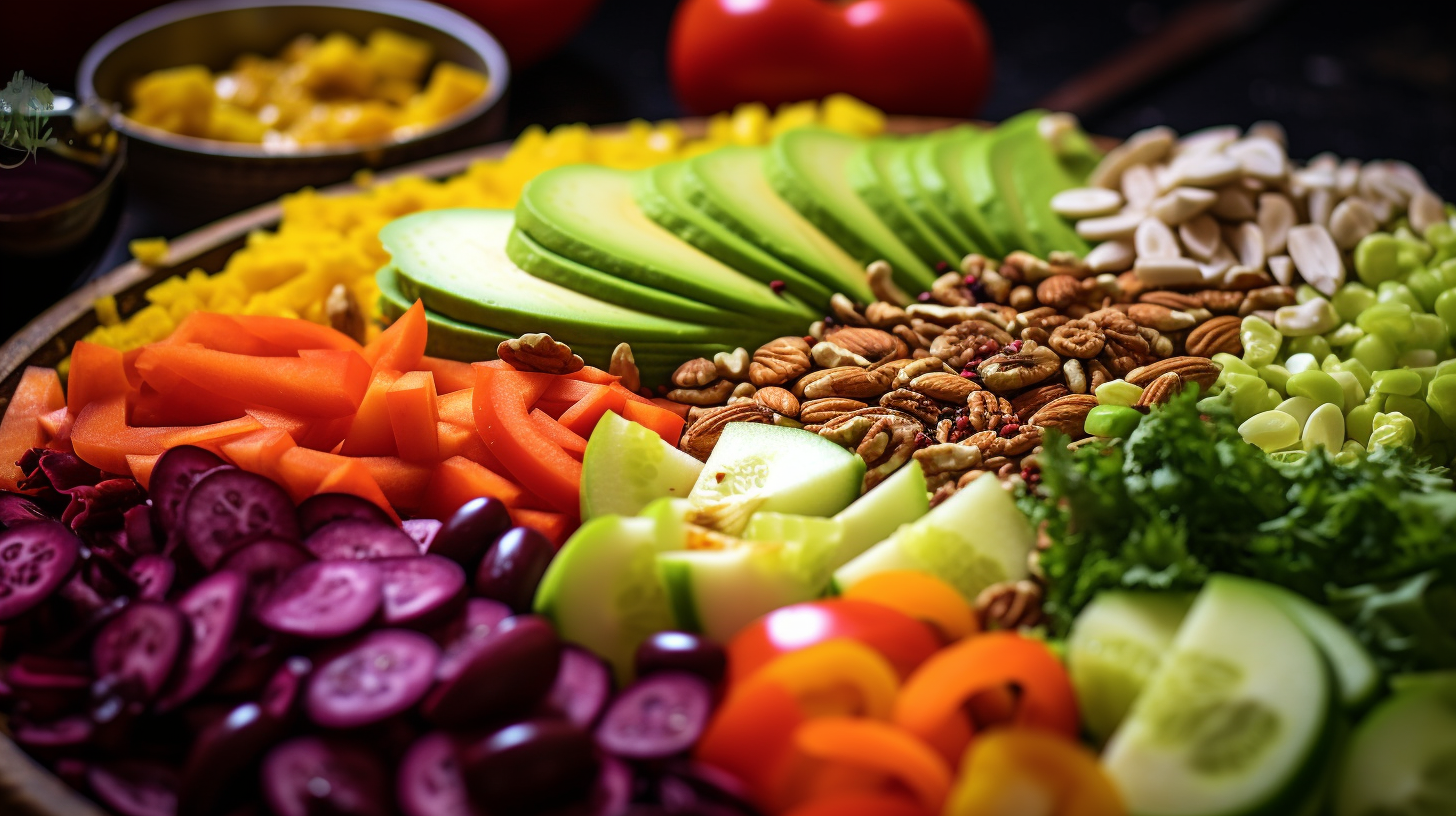
Hello everyone! I am knowledgeable about the raw food lifestyle, and I am here to share my knowledge on transitioning to a raw food diet.
Making the switch from cooked foods to an uncooked, plant-based lifestyle can seem challenging at first, but it’s absolutely possible. In this article I’ll discuss the benefits of eating raw, how you can make the transition easier on yourself, and provide some helpful tips for succeeding in your new journey.
Let’s get started!
I’ve been following a 100% raw vegan diet for over 10 years now and have seen firsthand the positive difference that it makes in people’s health. Eating mostly fruits and vegetables has so many amazing benefits – increased energy levels, improved digestion, better sleep quality, sharper mental clarity…the list goes on!
If you’re considering making the switch to a raw food diet then this article is definitely for you.
Understanding The Benefits Of A Raw Food Diet
I’m an expert on the raw food diet and I’ve seen first-hand just how life changing it can be. Let me tell you a bit about why this type of eating is so beneficial for your health and the environment.
When it comes to detoxifying benefits, there’s nothing like the raw food lifestyle. Eating unprocessed foods provides more vitamins, minerals, antioxidants, enzymes and phytonutrients than cooked items – making it easier for your body to filter out toxins and get rid of them in a natural way.
Plus, consuming organic produce has been known to reduce exposure to harmful pesticides, which can further contribute to better overall health.
The environmental impact of switching over to a raw food diet should also not be overlooked. By supporting local farms that practice sustainable agriculture methods such as crop rotation or composting, you’re helping reduce carbon emissions while at the same time providing yourself with healthier meals made up of fresh ingredients grown right here in your own backyard!
Now let’s take a look at what kind of changes you’ll need to make when transitioning into this new lifestyle…
Making The Transition To Raw Foods
It’s ironic that when it comes to eating raw foods, the first step is breaking old habits. After all, most of us have been conditioned since childhood to think that steaming or boiling vegetables are the only way they should be consumed. But believe me when I say, there’s a whole world waiting for you beyond your usual cooking methods!
Here are four ways you can make transitioning to a raw food diet easier:
-
Start slow – There’s no need to immediately jump into a full-on raw food lifestyle; just try swapping out one cooked meal with a raw one and see how it goes from there.
-
Be flexible – Don’t expect perfection right away; allow yourself some time and space to experiment with new flavors and textures before settling on what works best for you.
-
Get creative – Trying new recipes and playing around with different ingredients will help keep things interesting as you explore this new way of eating.
-
Find support – Surrounding yourself with people who know about healthy living may give you additional motivation and encouragement during tough times along the journey.
Now that we’ve established the basics of transitioning to a raw food diet, let’s move onto shopping for these delicious dishes…
Shopping For Raw Foods
Shopping for raw foods can be a little overwhelming at first. To make sure you’re getting the most bang for your buck, it’s important to do some price comparison and budgeting tips so that you can get started on the right foot.
When checking out local grocery stores and markets, check online beforehand to see if there are any coupons or discounts available. Ask around about what produce is in season, as seasonal items tend to cost less than those from other parts of the world that may have been imported. It also pays off to buy in bulk as long as you plan to eat everything before it goes bad.
When purchasing pantry staples like nuts, seeds, spices and dried fruits, look into buying them in bulk instead of individually packaged servings – this will save you money over time. Try shopping around different health food stores where they often carry these types of products at lower costs compared to mainstream grocers. Additionally, consider visiting farmer’s markets or joining a CSA program near you; not only will you find fresh organic produce but potentially significant savings too!
Raw food preparation requires an investment upfront with kitchen tools such as dehydrators and high-speed blenders which could be costly depending on how serious one wants to take their diet. However, once these appliances are acquired, they should last many years with proper care making them more affordable over time – plus having access to healthy snacks whenever needed is quite convenient!
Transitioning away from processed foods allows us greater control over our own nutritional needs while keeping spending within our budget – something we all appreciate!
Eating Seasonally
I’m a huge advocate of eating seasonally! There are so many amazing benefits from eating what’s in season – like better tasting, more nutritious food and cost savings.
Plus, you can get creative with seasonal recipes and find new flavors. When you shop for seasonal foods, you can be confident that you’re getting the freshest and best quality produce.
I’m excited to share some of my favorite seasonal recipes with you – they’re always so delicious and packed with nutrition!
Let’s dive into all the amazing benefits of eating seasonally.
Benefits Of Eating Seasonally
As you transition to a raw food diet, you’ll quickly see the benefits of eating seasonally.
Eating produce that has been harvested fresh from local sources helps your body access maximum nutrition and flavor – not to mention it’s often cheaper than store-bought options!
Not only does seasonal harvesting keep your meals interesting and help reduce waste, but by supporting local farmers, you can also help sustain their businesses.
Plus, when you’re cooking with ingredients that are in season, you get to enjoy them at their peak – no more bland or overripe fruits or veggies here!
With so many delicious alternatives available right now, there’s never been a better time to start exploring what nature has to offer.
So grab some seasonal produce today and treat yourself to an amazing plant-based meal!
Seasonal Recipes
As you become more familiar with seasonal produce, why not explore some of the recipes available? Cooking seasonally is a great way to maximize flavor and nutrition while saving money. Not only that but it also helps reduce food waste!
Storing your produce correctly is an important part of getting the most out of these ingredients when they’re in season – just check out our guide on storing fresh produce for tips and tricks. You can even get creative with exploring new flavors and textures – experiment with different herbs, spices, or combinations of ingredients to find something delicious!
There’s no limit to what you can create with seasonal ingredients, so let your culinary journey begin today!
Shopping For Seasonal Foods
When it comes to eating seasonally, shopping for seasonal foods is key. Exploring farmers’ markets or your local grocery store can be a great way to find food that’s in-season and of the highest quality. You’ll likely get the best flavor out of these ingredients, plus you’ll often get them at their cheapest prices! Not only that but you’re supporting your local community by buying from small businesses rather than big corporate names – so not only are you getting fresher produce but also helping support those around you.
It’s easy for cravings to take over when we shop for groceries which is why I recommend taking an inventory of what vegetables and fruits are currently in season before heading to the store. That way, you can make sure you’re picking up all the items on your list while still having room to explore new flavors and textures with different ingredients available in-season. This will help keep your meals interesting without feeling overwhelmed or stressed about managing cravings during a trip to the supermarket.
Eating seasonally doesn’t have to be complicated. With a little bit of planning and some creativity, you can turn any meal into something special using fresh, locally sourced ingredients – all while being mindful of how much money you’re spending and reducing food waste as well!
Stocking Your Kitchen
Once you have a good understanding of seasonal eating and what’s available to you, it’s time to stock your kitchen with the right cooking equipment and food storage containers. This will make preparing raw meals easier and more enjoyable!
If you’re just starting out on a raw food diet, investing in some basic tools like a blender, spiralizer or juicer can help you create delicious dishes without having to do too much preparation work. It is also important to invest in air-tight glass jars for storing foods that need refrigeration – this will keep them fresh for longer.
There are lots of great resources online where you can find recipes suitable for a raw food diet. You don’t have to be an experienced cook or chef to enjoy these meals either! Look up easy-to-follow videos or blogs that feature simple yet tasty recipes which use few ingredients so they won’t require any special skills or techniques.
With the right combination of ingredients, spices and flavors, even beginner cooks can whip up some amazing dinner ideas quickly and easily.
It’s now time to move onto creating a balanced meal plan tailored towards your needs and preferences. A healthy raw food diet should consist of plenty of vegetables, fruits, nuts, seeds, legumes and grains all prepared using natural methods such as blending or dehydrating.
Keep things interesting by trying new combinations each week – finding creative ways to combine different flavors into one dish makes life much tastier! As long as you stick to wholesome plant-based ingredients there’s no limit when it comes to experimenting with different tastes.
To get started on this journey today let’s explore how we can craft our own unique meal plans that suit our dietary requirements perfectly!
Creating A Balanced Meal Plan
Eating variety is key when transitioning to a raw food diet.
I recommend planning meals that include a variety of fruits, vegetables, nuts, seeds, and sprouted grains to ensure you’re getting all the nutrients you need.
Meal prepping is a great way to stay on track and save time.
Taking a few hours on the weekend to plan and prepare meals for the week ahead can make it easier to stick with your raw food diet.
Eating Variety
When transitioning to a raw food diet, it’s important to ensure you have variety in your meals. Eating the same things day after day can easily lead to burn out and cravings for unhealthy food!
To help create a balanced meal plan, I suggest incorporating different cooking techniques that keep recipes interesting without sacrificing nutrition. Raw vegan cuisine offers so many delicious options like dehydrating, sprouting and marinating – each with its own unique benefits.
When eating out or picking up prepared foods from the store, read labels carefully and try to find products made of whole plant-based ingredients. It may take some time but eventually you’ll discover amazing raw dishes wherever you go; don’t be afraid to get creative!
And remember: having an open mind is key when exploring new flavors and textures of this exciting way of eating.
Meal Planning Strategies
Meal planning is an essential component of creating a balanced raw food diet. With the right strategies, you can make sure that each meal provides your body with all the nutrition it needs while still being delicious and enjoyable.
To do this, I suggest focusing on plant-based substitutes for traditional ingredients like using cauliflower rice instead of white rice or zucchini noodles instead of wheat pasta. Additionally, be mindful when eating to ensure that you’re getting enough nourishing foods without overeating.
And finally, try to incorporate small treats every once in a while so that your meals don’t become monotonous; just remember to keep portion sizes reasonable! With these tips in mind, you’ll have no problem crafting healthy yet flavorful meals on a regular basis.
Ensuring Proper Nutrition
Transitioning to a raw food diet can be an exciting and health-promoting journey. But it’s important not to forget the basics of nutrition along the way. As with any dietary change, ensuring that our bodies are getting what they need is essential for sustained health over time.
To make sure you’re on the right track nutritionally, consider these suggestions:
-
Vitamin Supplementation: A well-rounded vitamin supplement may help fill in gaps where your daily raw food intake falls short. Look for a natural product free from additives or preservatives.
-
Nutrient Tracking: Use apps like MyFitnessPal to track your nutrient consumption each day – especially protein, iron, copper, zinc, magnesium, and calcium – all important nutrients found in raw foods but which may require extra attention during this transition period.
-
Educate Yourself: Become familiar with different types of raw ingredients available so you don’t find yourself missing out on vital vitamins or minerals due to lack of variety in your meals. It’s also helpful to read up on how best to combine certain foods together as part of a balanced meal plan.
By taking proactive steps such as these three, you will set yourself up for success while transitioning into a healthy raw food lifestyle! With proper preparation underway, we’ll now turn our attention towards finding recipes and meal ideas that excite and inspire us…
Finding Recipes And Meal Ideas
Making the transition to a raw food diet doesn’t have to be intimidating! With an abundance of recipes and meal ideas out there, you’ll easily find something that suits your tastes.
A great way to get started is by taste testing different foods. You can start with simple dishes like salads or smoothies before experimenting with more complex recipes. Once you’ve identified some favorites, budgeting for ingredients becomes much easier.
Eating raw meals at home is just one part of transitioning to this lifestyle; it’s also important to be able to eat out and dine with friends. When eating in restaurants, always double check that the food is indeed prepared without any form of cooking or heat processing.
This means avoiding fried items as well as processed meats and sauces – but don’t worry too much about not being able to enjoy restaurant meals entirely! There are plenty of delicious options available if you know what to look for.
Eating Out And Dining With Friends
Now that you’ve gotten a good handle on the basics of transitioning to a raw food diet, it’s time to start thinking about how to navigate eating out and dining with friends.
Eating out can be challenging for anyone who follows a restricted diet but with some tips and tricks from an expert in this field, it doesn’t have to be impossible or daunting.
First off, when it comes to eating out safely while following a raw food diet, there are several things you should keep in mind.
Make sure your server knows exactly what you need so they don’t accidentally bring something cooked or processed into your meal.
Be wary of any sauces or dressings as these may contain hidden ingredients like oil or sugar which could not only harm your transition goals but also make you sick if consumed at all.
Lastly, remember that most restaurants will happily accommodate dietary restrictions if asked nicely!
In terms of dining etiquette when eating with friends, always take the opportunity to educate them about the benefits of a raw food lifestyle without being pushy.
If someone offers you cooked dishes, politely explain why you cannot accept those foods right now and offer alternatives such as bringing over a dish yourself that everyone can share in.
Additionally, try not to get too caught up in trying to please everyone else; focus on taking care of yourself first and foremost – after all, that is the primary goal here!
With this mindset, navigating both eating out and dining with others becomes much easier.
It’s important however for us to also consider how we handle social pressure…
Dealing With Social Pressure
I understand that transitioning to a raw food diet can be difficult, especially when it comes to social pressure. Handling peer pressure can be especially tricky, so it’s important to remember to stay confident in your decision and not let others dictate your lifestyle choice.
When it comes to dealing with family opposition, try to be patient and understanding and explain why this is important to you. It’s also important to let them know that you will still be part of the family and still enjoy time with them.
When it comes to work, you may need to explain to your colleagues and employer why you are making this lifestyle choice. It’s important to remember that you have the right to make choices for yourself and don’t let anyone else pressure you into doing something you don’t want to do.
With the right attitude and support, transitioning to a raw food diet can be a positive and rewarding experience.
Handling Peer Pressure
When transitioning to a raw food diet, it can be difficult to handle peer pressure. Everyone is going to have their own opinions and these opinions can make it challenging for you to stick with your dietary choices. With that being said, there are some strategies I recommend when dealing with social pressure while embarking on this lifestyle change.
One of the most important things you can do is identify any triggers or cravings that might lead you away from eating raw foods. Once you’ve identified what those might be, try to come up with ways that will help overcome them so they don’t derail your progress.
This could look like planning ahead by bringing along a healthy snack wherever you go if hunger strikes unexpectedly or avoiding certain places where temptations may arise. By having an understanding of how best to address potential obstacles, you’ll set yourself up for success in sticking with the diet over time – even when others around you are trying to persuade otherwise!
Knowing your limits and staying true to yourself is key here; no matter what anyone else says about your decision, remember why you started in the first place and stay focused on achieving your goals.
Dealing With Family Opposition
When it comes to dealing with social pressure while transitioning to a raw food diet, family opposition can be one of the toughest challenges you face. Your loved ones may doubt your commitment or worry about how this change will affect your health, leading them to push back against your decision – but don’t let that stop you from achieving success!
Overcoming cravings and managing doubts is key here; by identifying what triggers might lead you away from eating raw foods and planning ahead for potential obstacles, you’ll have the tools necessary to stay on track no matter what anyone else says. It’s important to remember why you started in the first place and focus on reaching those goals rather than getting distracted by negative feedback.
Staying true to yourself is vital; if you’re confident in your decisions, then nothing anyone says should hold you back!
Addressing Workplace Concerns
When it comes to dealing with social pressure while transitioning to a raw food diet, workplace concerns can be just as difficult. This is especially true if your job requires you to eat out or have meals catered – but don’t worry! With some thoughtful planning and the right strategies in place, you’ll be able to make healthy choices even when eating at work.
It’s all about managing your cravings; by making sure you’re always prepared with snacks and having a plan for what to do on days where food isn’t accessible, you won’t find yourself tempted by unhealthy options. I’ve found that carrying fruits and veggie sticks on hand helps me stay on track no matter where I’m working from. In addition, trying to incorporate more of these foods into my regular meal times has helped keep me going throughout the day.
The bottom line is that following a raw food diet doesn’t have to mean sacrificing convenience – it’s totally possible to balance both without compromising your lifestyle! By changing up how you shop, cook and snack, you’ll be able to make healthier decisions no matter the situation. Allowing yourself time and room for flexibility will ensure success in the long run – so take it one step at a time and remember why this change was important to begin with.
Avoiding Boredom And Plateau
Easing into a raw food diet can be both exciting and daunting. While the health benefits of swapping processed foods for fresh fruits, vegetables, nuts and seeds are undeniable, it can be difficult to stick with this lifestyle change.
One key to avoiding boredom and plateau is increasing variety in your meals by trying new recipes and learning about different types of plant-based ingredients available to you. Start small by adding something new each week or month. If you’re used to eating salads every day try experimenting with other dishes like zucchini noodles or kale chips.
There’s an abundance of creative ways that raw foodists incorporate more variety into their diets from traditional smoothies to dehydrated snacks and mock meat substitutes made from mushrooms, tempeh and jackfruit! If you feel overwhelmed when starting out on this journey, don’t worry – take it one step at a time.
Find what works best for you as there’s no right or wrong way to do this. As long as you keep introducing new flavors and textures while staying mindful of portion size, balance nutrition needs, listen to your body’s cues – you’ll soon find yourself happily settled into your own unique version of the raw food diet!
With these strategies incorporated into your routine, transitioning to a healthier lifestyle will become easy and enjoyable! Onward we go towards integrating exercise into our daily lives…
Following An Exercise Regimen
Once you have transitioned to a raw food diet, it is important to follow an exercise regimen. Exercise can help boost your energy and metabolism which will enhance the effects of eating raw foods.
Plant based proteins such as lentils and quinoa are great sources of energy for workouts because they provide sustained fuel instead of a quick sugar rush that comes with processed carbohydrates. Raw juicing can also be beneficial when working out, using vegetable juices like celery and carrot juice or fruit juices such as pineapple and orange juice for hydration and electrolytes.
It’s essential to find an activity that fits into your lifestyle whether it’s walking the dog in the morning, yoga at night or biking over lunchtime – any physical movement counts! Regularly moving your body helps strengthen muscles while improving flexibility, balance, coordination and overall well-being.
When done on a consistent basis, exercising regularly can make you feel healthy, energized, reduce stress levels and improve your mood. In order to stay motivated during exercises its best to keep track of progress by recording each workout session in some way such as writing down how many reps were completed or noting improved speed from one session to another.
This visual feedback not only encourages consistency but provides an extra layer of motivation when goals are met or exceeded. Keeping yourself hydrated before, during and after workouts is an important part of reaping the maximum benefits from exercise…
Staying Hydrated
As you transition to a raw food diet, it is important to stay hydrated. Staying hydrated can be difficult when limiting your diet, but there are many ways that you can get the fluids you need while still staying true to your new lifestyle.
You may have heard that drinking sugary drinks or caffeine-laden beverages are necessary for good hydration, but this is not necessarily the case! Raw foods contain ample amounts of water and other hydrating liquids that keep us refreshed throughout the day. Eating plenty of fruits and vegetables will provide nutrition as well as plenty of fluids in our diets.
Additionally, adding herbs like basil or mint to salads and dishes will increase your fluid intake without sacrificing flavor. Furthermore, certain types of nuts such as cashews also contain high levels of liquid content which makes them ideal snacks for people on a raw food diet who want to remain properly hydrated.
It’s essential to adjust one’s drinking habits when transitioning to a raw food diet by replacing unhealthy options with more wholesome alternatives. A few examples include: switching from sodas and energy drinks to herbal teas; replacing coffee with freshly squeezed juices; and opting for smoothies over milkshakes. All these options make great hydrating drinks and they’re delicious too!
Moreover, having access to natural spring waters nearby can help ensure adequate hydration during hot summer days. By making mindful choices about what we drink, we can easily maintain proper hydration levels even when following a raw food diet.
So don’t let anyone tell you otherwise – take control of your health today by developing better drinking habits!
Developing A Support System
Making the transition to a raw food diet can seem overwhelming. It’s important to create a support system when you begin your journey.
Seeking guidance from other experienced raw foodists and finding resources online are essential steps toward success. Many people find that joining local meetup groups or participating in online forums is helpful for getting advice on transitioning, meal planning and sourcing ingredients.
It’s also beneficial to seek out mentors who have been successful with raw foods for many years. You’ll be able to learn about their strategies for staying motivated and overcoming any challenges they faced along the way. Additionally, it’s wise to research recipes that align with your dietary goals and develop an understanding of nutrition science as it relates to this type of dieting.
Having a strong network of support can make all the difference when embarking on a new lifestyle change like this one. With the right combination of knowledge, motivation and guidance, you can ensure that your raw food experience will be both enjoyable and fulfilling!
Now let’s move onto making the most of your raw food journey.
Making The Most Of Your Raw Food Journey
Making the Most of Your Raw Food Journey can be a fun and rewarding experience. As raw food diet experts, we know how important it is to find cooking methodologies that work for you. By taking advantage of the variety of raw ingredients available, you’ll discover flavors, textures and combinations that will satisfy your taste buds while nourishing your body.
One key to success on this journey is to keep in mind there are no hard-and-fast rules when it comes to enjoying raw foods. Experimenting with different seasonings and spices as well as trying out new recipes can help you make the most of this lifestyle change.
Additionally, don’t forget to include healthy snacks like fruit or vegetables throughout your day to stay energized and focused on achieving your wellness goals.
When navigating through the transition from cooked meals to eating more unprocessed raw foods, remember it’s all about balance and finding what works best for you. Keep an open mind while exploring alternate ways of preparing meals – grating veggies instead of chopping them, blending fruits into smoothies or juices, dehydrating nuts and seeds – these simple tweaks can help bring creativity back into mealtime!
With patience and dedication towards making healthier dietary choices, soon enough you’ll be reaping the rewards of living a raw lifestyle.
Frequently Asked Questions
What Is The Best Way To Make The Transition To A Raw Food Diet?
Making the transition to a raw food diet can seem daunting, but with some careful planning it doesn’t have to be.
When beginning your journey into eating more raw foods, it’s important to choose wisely when selecting what goes on your plate.
Start by increasing your intake of fresh fruits and vegetables – these are the building blocks for a healthier lifestyle and should form the foundation of any well-balanced diet.
Then gradually add in seeds, nuts and sprouted grains which will provide essential vitamins, minerals and proteins.
As you become familiar with different ingredients and how they work together, you’ll find that transitioning to a raw food diet becomes easier than ever before!
How Much Time Should Be Spent Preparing Raw Food Meals?
When it comes to preparing raw food meals, the amount of time you spend will depend on how much you want to prepare.
If you’re just starting out, sourcing ingredients and stocking your pantry can take some time.
That said, once you get used to the process and have a few staples in place, putting together meals doesn’t need to be overly complicated or time-consuming.
You don’t need to go all-in right away; gradually adding more raw foods into your diet is totally fine too!
Are There Any Tips For Eating Out While On A Raw Food Diet?
Heading into the 21st century, socializing and dining etiquette have become a major part of our lives. As a raw food diet expert, I get asked all the time about tips for eating out while on a raw food diet.
The truth is that it can be hard to find meals that fit within your dietary needs when going out with friends or family. But don’t worry! With some careful planning and smart choices you can still enjoy delicious and nutritious meals without breaking your lifestyle commitment.
Here are my top five tips for staying healthy while dining out:
- Ask questions about ingredients and preparation methods.
How Can I Get The Most Out Of My Raw Food Journey?
If you’re looking to get the most out of your raw food journey, the best place to start is stocking your kitchen with foods that are in season.
Eating seasonally helps ensure that all fruits and vegetables you eat are ripe and nutrient-dense, so take a look at what’s coming into stores or farmers markets near you.
Once you’ve stocked up on seasonal produce, make sure to keep it as fresh as possible by storing it correctly – this means avoiding plastic packaging where possible and using glass containers if needed.
And don’t forget to experiment! There’s no wrong way to enjoy a raw food diet; just have fun with it and explore different recipes, flavors and textures!
Are There Any Recipes That Are Good For Beginners?
Stocking your kitchen and selecting the right ingredients is key to making delicious raw food recipes.
As a raw food diet expert, I often recommend beginner-friendly dishes like zucchini pasta salad with pesto, kale chips, or avocado toast.
These vegan options are quick and easy to make while also full of essential nutrients.
You can find variations on these recipes all over the internet or even create your own!
Don’t be afraid to experiment in the kitchen; you may just discover some new favorites.
What are the Benefits of Transitioning to a Raw Food Diet?
Embarking on a raw food transformation journey can lead to numerous health benefits. Raw foods are rich in essential nutrients, enzymes, and antioxidants that support overall well-being. Additionally, transitioning to a raw food diet may enhance digestion, increase energy levels, and promote weight loss.
Conclusion
Making the transition to a raw food diet can be daunting but it doesn’t have to be. With the right information and preparation, you can make this journey an enjoyable one!
Believe it or not, I was in your shoes once. I know how overwhelming all of the changes can feel, but with a little bit of planning and guidance, making this change will become easier every day.
You are capable of finding success on your raw food journey – so don’t hesitate to take that first step today!
Lorraine, a talented writer for rachaelsrawfood.com, brings a unique blend of creativity and expertise to the platform. With her passion for writing and deep knowledge of raw food, she plays a crucial role in inspiring and educating readers about the joys and benefits of a raw food lifestyle.
Lorraine’s creativity shines through in her recipe development. She enjoys experimenting with unique flavor combinations and innovative cooking techniques, pushing the boundaries of what can be achieved with raw ingredients. Her recipes not only showcase the incredible taste and variety of raw food but also demonstrate that a raw food diet can be exciting, diverse, and satisfying.
In addition to her writing contributions, Lorraine actively seeks out new trends, research, and developments in the field of raw food. She attends workshops, conferences, and culinary events, constantly expanding her knowledge and staying up to date with the latest discoveries. This commitment to continuous learning ensures that her writing remains current, reliable, and relevant to the ever-evolving landscape of raw food.
Lorraine’s genuine enthusiasm for raw food is contagious, and she strives to connect with readers personally. She understands that embracing a raw food lifestyle can be a journey, and she uses her writing to provide guidance, support, and encouragement to individuals at all stages of their journeys. Her empathetic approach and storytelling make her a trusted and relatable voice in the raw food community.
Transitioning to a Raw Food Diet
Your 7-Day Raw Food Diet Plan
Embark on a health journey with the Ultimate 7-Day Raw Food Diet Plan, rejuvenating your body with natural, plant-based goodness.
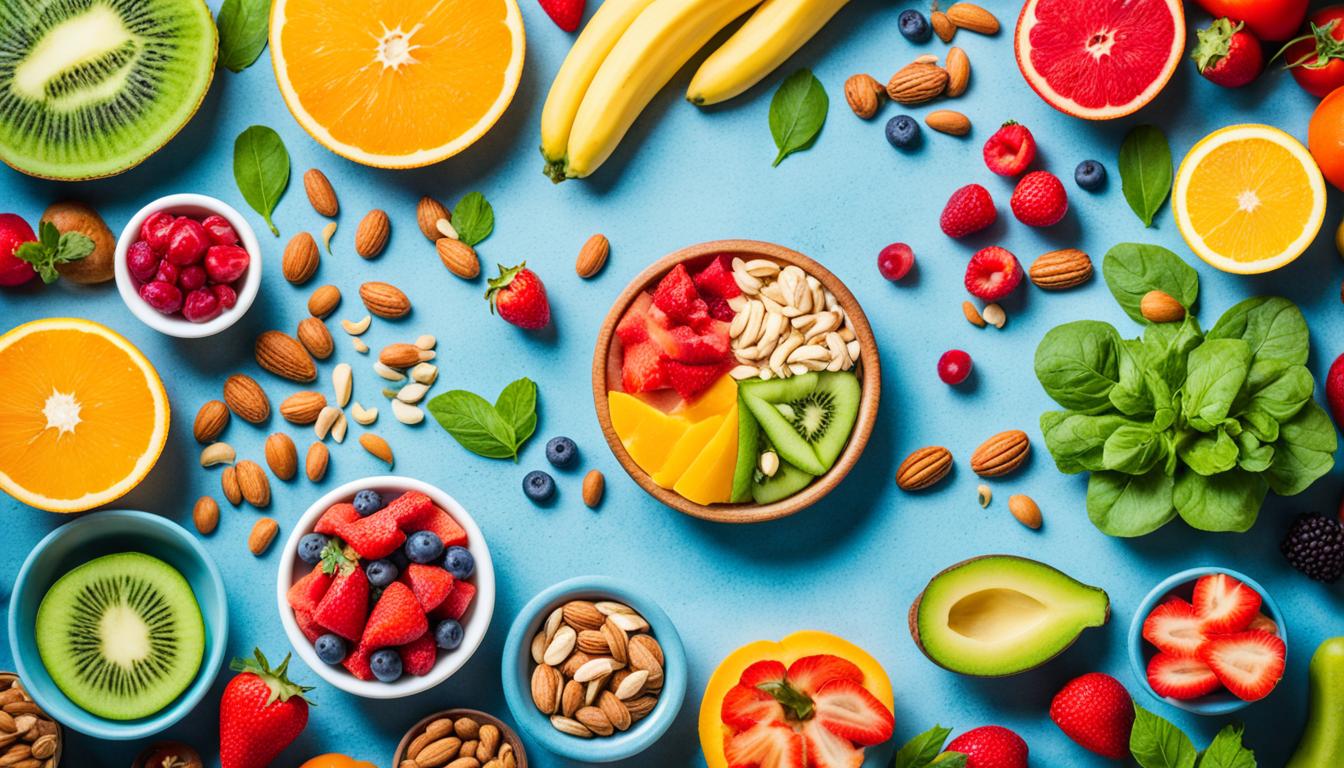
Did you know that a raw food diet is not just a passing trend, but a scientifically proven method to revitalize your body and enhance your overall well-being? By following the Ultimate 7-Day Raw Food Diet Plan, you can enjoy the incredible benefits of a plant-based lifestyle. This detailed meal plan is specifically crafted to cleanse and fuel your body with wholesome, raw vegan meals and snacks, assisting you in resetting your taste buds, boosting your consumption of fruits and vegetables, and unleashing the potential of a raw food diet.
Key Takeaways:
- Embark on a 7-day journey to detoxify and nourish your body with the Ultimate Raw Food Diet Plan.
- Enjoy a variety of raw vegan meals and snacks to reset your palate and increase your intake of fruits and vegetables.
- Experience the benefits of a raw food diet, including improved digestion, weight loss, disease prevention, and overall well-being.
- Equip your kitchen with the necessary tools and follow simple tips for success on a raw food diet.
- Explore delicious raw food recipes that will inspire and satisfy your taste buds.
What Is a Raw Food Diet?
A raw food diet is a dietary approach that combines veganism and raw foodism. It involves consuming uncooked, unprocessed foods that have not been heated above 118 degrees Fahrenheit. This diet focuses on the consumption of raw fruits, vegetables, nuts, seeds, sprouts, and smoothies. It excludes animal products, cooked foods, processed sugars, and alcohol. Raw foodism emphasizes the benefits of consuming food in its natural state, retaining its nutrients and enzymes.
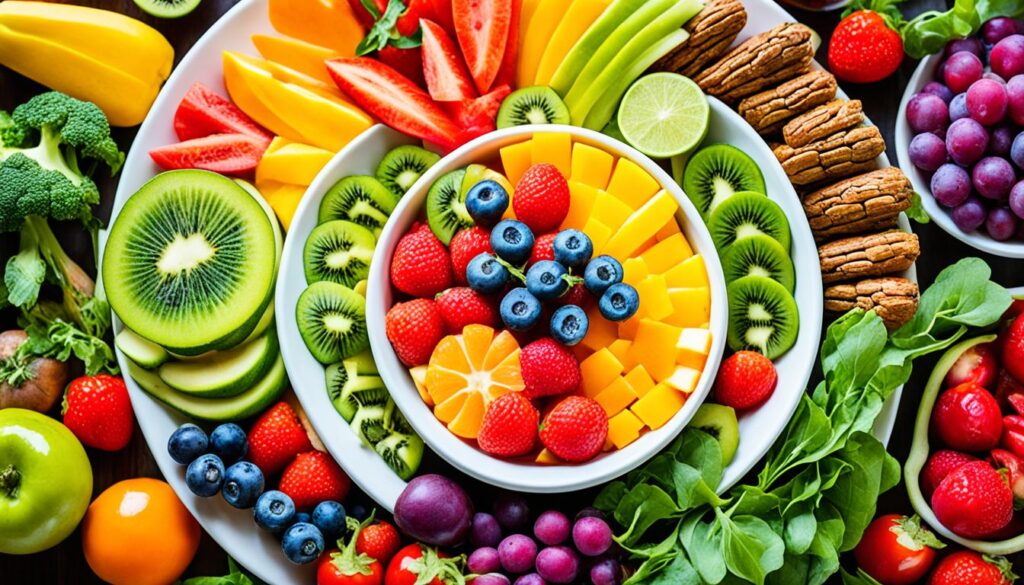
Benefits of a Raw Food Diet
The raw food diet offers numerous benefits for your overall health and well-being. By following a raw food diet and consuming a variety of raw, plant-based foods, you can maximize nutrient absorption, prevent diseases, promote weight loss, and cleanse your body. Let’s explore the key benefits of adopting a raw food lifestyle:
Maximizing Nutrient Absorption
Raw foods are rich in essential nutrients and enzymes that are easily absorbed by your body. By consuming foods in their natural, uncooked state, you unlock their full nutritional potential. This allows for optimal digestion and nutrient absorption, ensuring that your body receives the vitamins, minerals, and antioxidants it needs for optimal functioning.
Disease Prevention
A raw food diet, which is predominantly plant-based, has been shown to reduce the risk of chronic diseases. The abundance of fiber, antioxidants, and healthy fats found in raw foods can help prevent diseases such as cancer and heart disease. By nourishing your body with nutrient-dense, plant-based foods, you provide it with the tools to fight off diseases and maintain optimal health.
Weight Loss and Management
Raw foods are naturally low in calories and high in fiber, making them a great choice for weight loss and management. The high fiber content keeps you feeling full and satisfied, reducing the likelihood of overeating. Additionally, raw foods are nutrient-dense, providing your body with the essential nutrients it needs while also promoting weight loss by creating a calorie deficit.
Cleansing and Detoxification
Consuming raw, plant-based foods helps cleanse your body and eliminate toxins. Raw foods are rich in fiber, which aids in removing waste from your digestive system and promoting regular bowel movements. The high water content in raw fruits and vegetables also helps flush out toxins and support overall detoxification.
Whole Foods and Nutrient Variety
A raw food diet emphasizes whole, unprocessed foods, ensuring that you consume a wide variety of nutrients. This can help address any nutritional deficiencies and promote overall well-being. By incorporating a diverse range of fruits, vegetables, nuts, seeds, and sprouts into your diet, you nourish your body with a variety of vitamins, minerals, and antioxidants.
Benefits Description Maximizing Nutrient Absorption Raw foods provide essential nutrients and enzymes that are easily absorbed by the body, promoting optimal digestion and nutrient absorption. Disease Prevention A raw food diet, rich in fiber, antioxidants, and healthy fats, can help prevent chronic diseases such as cancer and heart disease. Weight Loss and Management Raw foods are low in calories and high in fiber, making them ideal for weight loss and maintaining a healthy weight. Cleansing and Detoxification Raw foods support the body’s natural detoxification processes, helping to cleanse and eliminate toxins. Whole Foods and Nutrient Variety A raw food diet emphasizes whole, unprocessed foods, providing a wide range of nutrients and promoting overall well-being.
“The raw food diet offers a multitude of benefits for your health, ranging from maximizing nutrient absorption to preventing diseases and promoting weight loss. By embracing a raw food lifestyle and prioritizing whole, plant-based foods, you can cleanse your body, nourish it with essential nutrients, and experience the transformative power of raw foods.”

Getting Started on a Raw Food Diet
To embark on a raw food diet journey, it’s crucial to equip your kitchen with the necessary tools and embrace a few essential tips. With these key elements in place, you’ll be on your way to success in no time.
1. Kitchen Equipment
Having the right kitchen equipment is essential for preparing raw food meals. Here are the must-have tools:
Equipment Usage Blender Perfect for making nutritious smoothies and juices. Juicer Great for extracting juice from various fruits and vegetables. Chef’s knife and cutting board Essential for chopping fruits, vegetables, and other raw ingredients. Storage containers Keep your fresh ingredients organized and preserved.
2. Tips for Success
- Focus on what you can eat: Rather than dwelling on what you’re giving up, shift your focus to the exciting variety of delicious raw food options available to you. Embrace the abundance of fruits, vegetables, nuts, seeds, and sprouts that make up the raw food diet.
- Eat enough to meet your nutritional needs: Ensure you’re consuming a sufficient amount of calories and nutrients to support your body’s requirements. Raw food meals can be filling and satisfying when planned properly.
- Educate yourself about the raw food diet: Take the time to learn about the principles, benefits, and potential challenges of a raw food diet. Arm yourself with knowledge to make informed decisions about your health.
- Plan your meals in advance: Create a meal plan for the week to stay organized and focused on your raw food diet goals. This will help you avoid last-minute temptations and ensure you have all the necessary ingredients on hand.
- Keep it simple with mono meals: Embrace the simplicity of raw food by enjoying mono meals, which consist of a single type of fruit or vegetable. These meals are easy to prepare and allow you to fully savor the flavors and nutrients of the chosen ingredient.
- Drink plenty of water: Hydration is key, so make sure to drink an adequate amount of water throughout the day. This helps support digestion and overall well-being.
- Get plenty of rest: Rest is essential for your body’s recovery and overall health. Aim for a good night’s sleep and listen to your body’s signals for restorative breaks during the day.
By following these tips and setting up your kitchen with the necessary equipment, you’ll be well-prepared to embrace the raw food diet and embark on a journey of enhanced wellness.
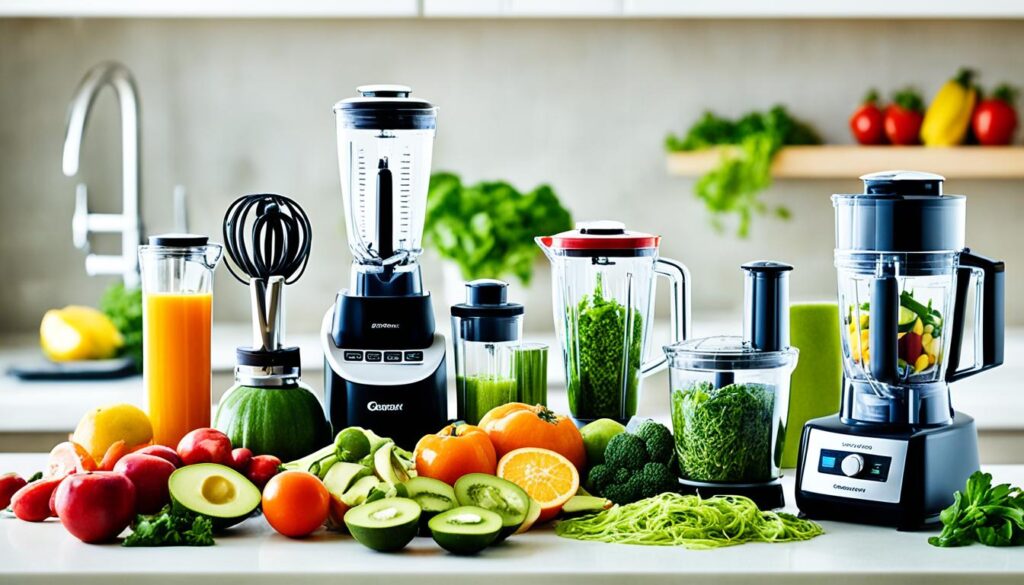
7-Day Raw Food Diet Meal Plan
Follow this 7-day raw food diet meal plan to experience the incredible benefits of a raw food diet. This plan offers a variety of delicious and nourishing raw vegan meals throughout the week, ensuring that you stay satisfied and motivated on your health journey.
Day 1
- Breakfast: Green Smoothie Bowl
- Lunch: Raw Taco Lettuce Wraps
- Dinner: Zucchini Noodles with Creamy Garlic Cashew Sauce
- Snack: Fresh Watermelon Slices
Day 2
- Breakfast: Chia Pudding with Berries
- Lunch: Rainbow Salad with Lemon Tahini Dressing
- Dinner: Raw Veggie Pad Thai
- Snack: Raw Almond Butter Energy Balls
Day 3
- Breakfast: Tropical Smoothie with Mango and Pineapple
- Lunch: Raw Falafel with Tahini Sauce
- Dinner: Avocado Rolls with Spicy Peanut Dipping Sauce
- Snack: Fresh Strawberries and Blueberries
Day 4
- Breakfast: Raw Acai Bowl
- Lunch: Raw Zucchini Pasta with Basil Pesto
- Dinner: Raw Tomato Basil Soup
- Snack: Veggie Sticks with Sunflower Seed Hummus
Day 5
- Breakfast: Green Detox Smoothie
- Lunch: Raw Spring Rolls with Peanut Dipping Sauce
- Dinner: Cauliflower Rice Sushi Rolls
- Snack: Mango and Coconut Chia Pudding
Day 6
- Breakfast: Berry Banana Smoothie
- Lunch: Raw Mediterranean Salad
- Dinner: Raw Vegan Curry Over Zucchini Noodles
- Snack: Raw Trail Mix with Nuts and Dried Fruits
Day 7
- Breakfast: Green Mojito Smoothie
- Lunch: Raw Walnut Taco Salad
- Dinner: Raw Pizza with Zucchini Crust
- Snack: Raw Chocolate Energy Balls
Feel free to experiment with these recipes and customize them to suit your taste preferences. Remember to drink plenty of water throughout the day to stay hydrated and support the detoxifying process. Enjoy the abundance of flavors and nutrients that a raw food diet has to offer!
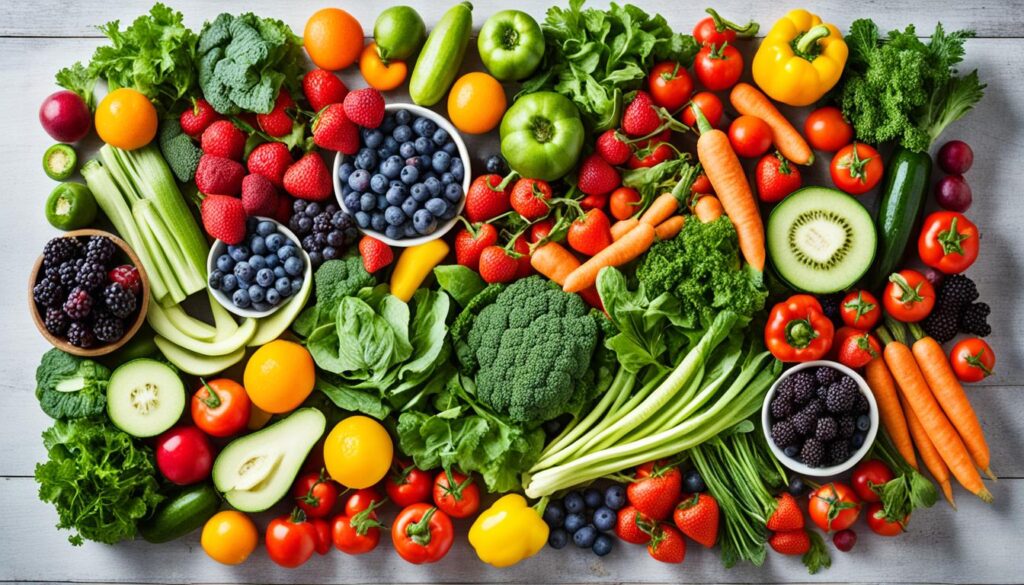
| Day | Breakfast | Lunch | Dinner | Snack |
|---|---|---|---|---|
| 1 | Green Smoothie Bowl | Raw Taco Lettuce Wraps | Zucchini Noodles with Creamy Garlic Cashew Sauce | Fresh Watermelon Slices |
| 2 | Chia Pudding with Berries | Rainbow Salad with Lemon Tahini Dressing | Raw Veggie Pad Thai | Raw Almond Butter Energy Balls |
| 3 | Tropical Smoothie with Mango and Pineapple | Raw Falafel with Tahini Sauce | Avocado Rolls with Spicy Peanut Dipping Sauce | Fresh Strawberries and Blueberries |
| 4 | Raw Acai Bowl | Raw Zucchini Pasta with Basil Pesto | Raw Tomato Basil Soup | Veggie Sticks with Sunflower Seed Hummus |
| 5 | Green Detox Smoothie | Raw Spring Rolls with Peanut Dipping Sauce | Cauliflower Rice Sushi Rolls | Mango and Coconut Chia Pudding |
| 6 | Berry Banana Smoothie | Raw Mediterranean Salad | Raw Vegan Curry Over Zucchini Noodles | Raw Trail Mix with Nuts and Dried Fruits |
| 7 | Green Mojito Smoothie | Raw Walnut Taco Salad | Raw Pizza with Zucchini Crust | Raw Chocolate Energy Balls |
Raw Food Diet Recipes
Incorporate delicious raw food recipes into your diet with this collection of raw vegan meals. Try refreshing smoothies like the Berry Banana Smoothie and the Green Mojito Smoothie. These nutrient-packed drinks are perfect for starting your day or enjoying as a mid-afternoon pick-me-up.
For satisfying entrees, indulge in the Cucumber Avocado Rolls or the Raw Vegan Curry Over Zucchini Noodles. These flavorful dishes showcase the versatility of raw food cooking, combining vibrant vegetables and delectable seasonings.
Are you craving a wholesome salad? Try the Shredded Carrot Zucchini Salad or the Mediterranean Salad. These refreshing salads are packed with nutrients and bursting with flavors, satisfying both your taste buds and nutritional needs.
Explore the world of raw food cooking with these recipes and discover the endless possibilities of creating healthy and delicious meals with plant-based ingredients.
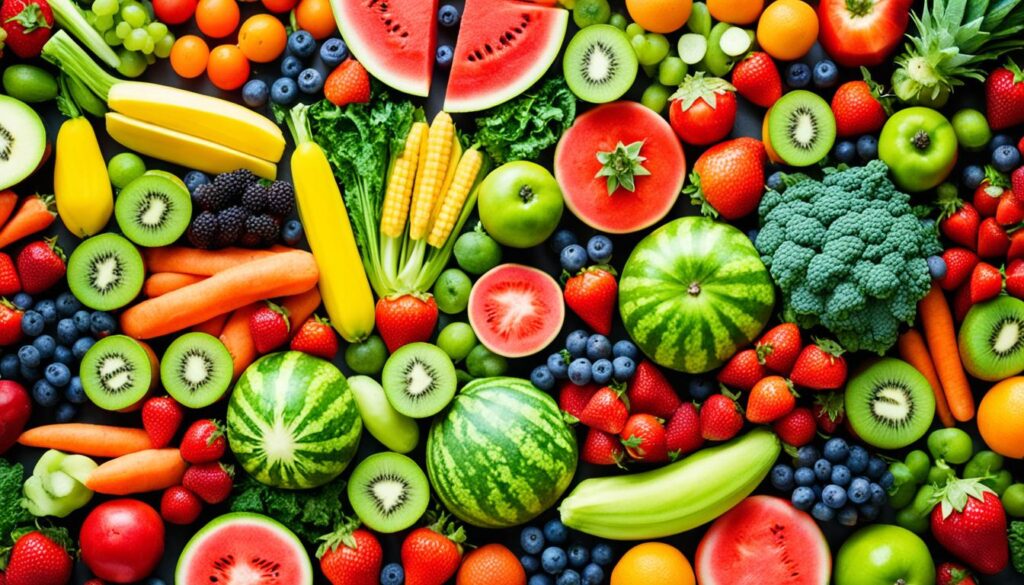
Tips for Success on a Raw Food Diet
Embarking on a raw food diet can be a transformative journey towards improved health and well-being. To ensure success on this path, it is important to keep a few key tips in mind. By following these guidelines, you can maximize the benefits of a raw food diet and create a sustainable lifestyle that supports your goals.
Educate Yourself about the Raw Food Diet
Before diving into a raw food diet, take the time to educate yourself about its principles and potential benefits. Understanding the nutritional value of raw foods, the importance of proper hydration, and the simplicity of meal planning can empower you on your journey. There are numerous resources available, such as books, documentaries, and online communities, where you can find valuable information and insights.
Plan Your Meals in Advance
Meal planning is an essential aspect of a successful raw food diet. By planning your meals in advance, you can ensure that you have a variety of nutritious options readily available. Consider creating a weekly meal plan that includes a balance of fruits, vegetables, nuts, seeds, and sprouts. This will not only simplify your grocery shopping but also help you stay on track with your dietary goals.
Keep Your Meals Simple with Mono Meals
One of the beauties of a raw food diet is its simplicity. Embrace the concept of mono meals, which involve consuming a single type of food for a meal. For example, have a meal consisting of just watermelon or a bowl full of berries. Mono meals allow your digestive system to focus on one type of food at a time, making it easier to digest and absorb nutrients effectively.
Stay Hydrated
Hydration is crucial for overall health and well-being, especially when following a raw food diet. Raw fruits and vegetables naturally contain high water content, contributing to your hydration needs. However, it is essential to drink plenty of water throughout the day to maintain optimal hydration levels. Aim to drink at least eight glasses of water per day, and consider incorporating hydrating beverages like herbal teas and infused water into your routine.
Get Plenty of Rest
Rest is an often overlooked but vital component of any healthy lifestyle, including a raw food diet. Proper rest supports your body’s natural healing processes and helps maintain mental clarity and energy levels. Aim for a consistent sleep schedule and prioritize quality sleep. Create a relaxing bedtime routine, limit technology use before bed, and create a comfortable sleeping environment to ensure you get the rest you need.
| Tips for Success on a Raw Food Diet | Summary |
|---|---|
| Educate yourself about the raw food diet | Gather information from reputable sources to understand the principles and benefits of a raw food diet. |
| Plan your meals in advance | Create a weekly meal plan to simplify grocery shopping and stay on track with your dietary goals. |
| Keep your meals simple with mono meals | Embrace mono meals by consuming a single type of food for a meal, allowing for easier digestion and nutrient absorption. |
| Stay hydrated | Drink plenty of water and incorporate hydrating beverages to maintain optimal hydration levels. |
| Get plenty of rest | Prioritize quality sleep and create a relaxing bedtime routine to support your body’s natural healing processes. |
By following these tips, you can set yourself up for success on a raw food diet. Remember to stay informed, plan ahead, embrace simplicity, stay hydrated, and prioritize rest. These habits will not only support your health journey but also help you enjoy the benefits of a raw food lifestyle to the fullest.
Risks of the Raw Food Diet
While the raw food diet offers many benefits, it is important to be aware of the potential risks associated with this dietary approach. Here are some key factors to consider:
1. Malnutrition
The raw food diet, particularly when followed strictly, can increase the risk of malnutrition. Since this diet is typically low in protein and calories, it is essential to ensure that you are meeting your nutritional needs. It is important to include a variety of plant-based protein sources such as legumes, nuts, and seeds to avoid deficiencies.
2. Digestive Issues
The high fiber content of raw foods can lead to digestive issues if not consumed in moderation. While fiber is important for digestive health, excessive intake can cause problems such as diarrhea or constipation. It is crucial to listen to your body and find a balance that works for you.
3. Calorie Intake
Raw foods, especially fruits and vegetables, are generally lower in calories compared to cooked foods. While this can be beneficial for weight loss, it is important to ensure that you are consuming enough calories to meet your energy needs. Lack of calorie intake can lead to fatigue, weakness, and other health concerns.
It is important to approach the raw food diet with caution and make sure you are adequately meeting your nutritional needs. Consulting with a healthcare professional or registered dietitian can provide valuable guidance and ensure you are following a well-rounded eating plan.
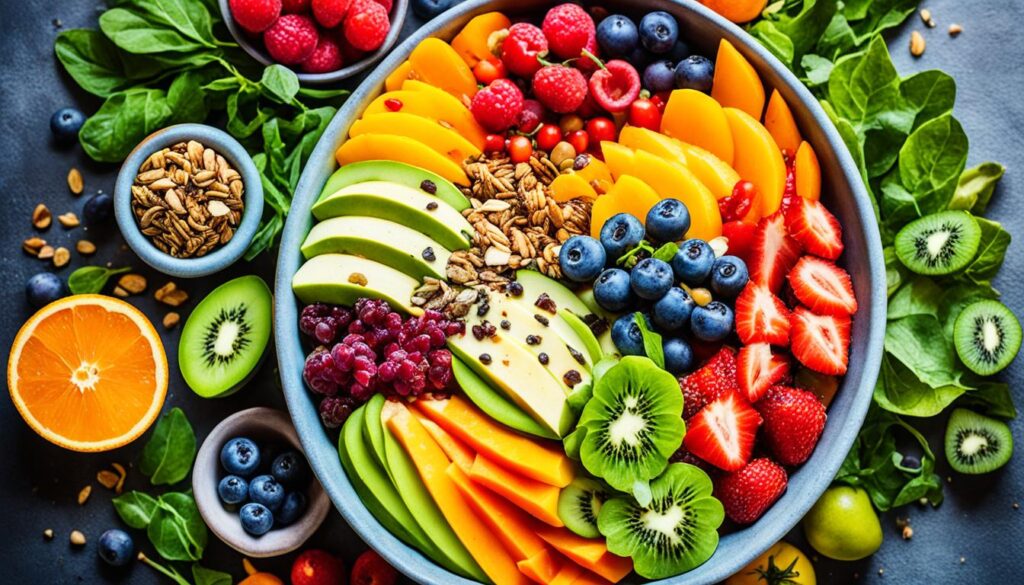
| Risks of the Raw Food Diet | Prevention and Solutions |
|---|---|
| Malnutrition | Include a variety of plant-based protein sources and monitor your nutrient intake. |
| Digestive Issues | Consume raw foods in moderation and ensure a balanced diet. |
| Calorie Intake | Pay attention to your energy needs and ensure you are consuming enough calories. |
Raw Food Diet vs. Cooked Food Diet
The raw food diet and cooked food diet differ in their approach to food consumption and nutrition. While the raw food diet promotes the consumption of uncooked, plant-based foods, the cooked food diet includes a variety of cooked and processed foods. Both diets have their own benefits and considerations to keep in mind.
One key difference between the two diets is the preservation of nutrients. Cooking food can lead to nutrient loss, especially the destruction of enzymes and heat-sensitive nutrients. Raw foodists believe that consuming food in its natural state maximizes its nutritional value and promotes optimal health. By eating raw, plant-based foods, they aim to preserve nutrients and enzymes that may be lost through cooking. However, it is important to note that cooking can also enhance the nutrient availability of certain foods, making them easier to digest and absorb.
Another distinction lies in the types of foods each diet emphasizes. The raw food diet focuses on uncooked fruits, vegetables, nuts, seeds, and sprouts, while cooked food diets include a wider range of food options, such as grains, legumes, dairy, and meat. Cooked food diets often provide a greater variety of flavors and textures, leading to a more diverse eating experience.
Both raw and cooked food diets can be part of a healthy and balanced approach to eating. The key is to prioritize nutrient-dense foods while ensuring a well-rounded intake of essential nutrients. It’s essential to consider individual preferences, dietary restrictions, and health goals when deciding which approach is best for you.
I believe that incorporating a combination of raw and cooked foods into your diet can offer the best of both worlds. By including raw foods, you can benefit from the intact enzymes and nutrients they provide. On the other hand, cooking certain foods can enhance their flavor, improve digestibility, and increase nutrient availability. It’s all about finding a balance that works for your body and lifestyle.
The Pros and Cons of Raw Food and Cooked Food Diets
| Raw Food Diet | Cooked Food Diet | |
|---|---|---|
| Pros |
|
|
| Cons |
|
|
Ultimately, the choice between a raw food diet and a cooked food diet is a personal one. It’s important to listen to your body, consult with a healthcare professional, and make dietary decisions that align with your health goals and individual needs.
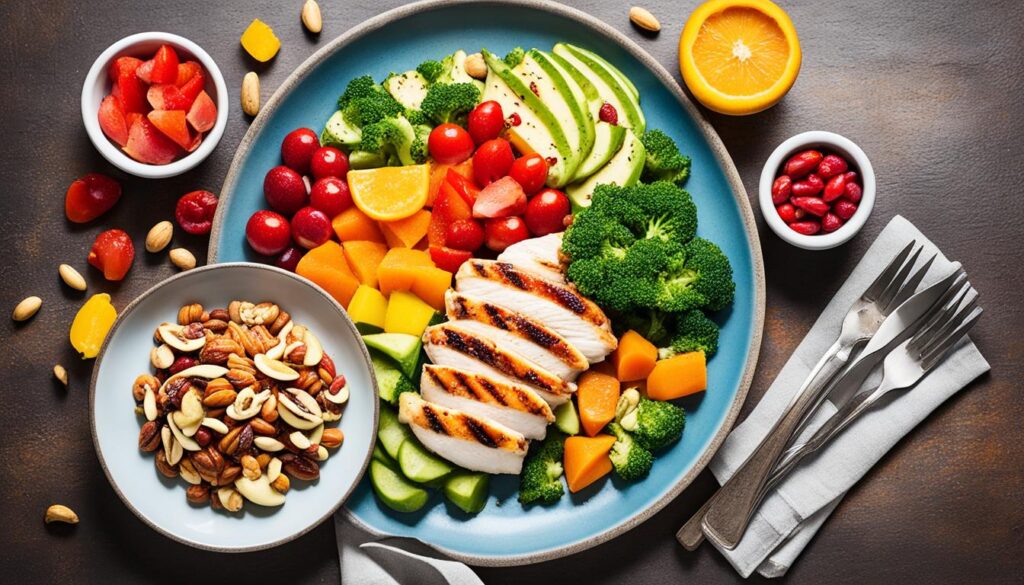
Raw Food Diet and Weight Loss
The raw food diet can be an effective approach for achieving weight loss goals. By focusing on nutrient-dense, low-calorie foods, you can create a calorie deficit and promote weight loss. Raw foods are generally lower in calories and higher in fiber, which helps you feel full and satisfied while consuming fewer calories. Moreover, the high water content in raw fruits and vegetables aids in hydration and weight management.
When following a raw food diet for weight loss, it’s important to prioritize nutrient density. By choosing foods that are rich in vitamins, minerals, and antioxidants, you can nourish your body while also reducing calorie intake. This ensures that you’re getting the essential nutrients your body needs to function optimally, even while in a calorie deficit.
By focusing on nutrient-dense, low-calorie foods, the raw food diet can support weight loss goals while nourishing the body with essential vitamins and minerals.
In addition, the higher fiber content in a raw food diet can contribute to weight loss. Fiber helps promote healthy digestion, regulates blood sugar levels, and aids in weight management by increasing satiety and reducing overall calorie intake. Raw foods are naturally rich in fiber, which makes them a great choice for those looking to lose weight.
Furthermore, the raw food diet encourages the consumption of whole, unprocessed foods. These foods often have a lower caloric density than processed foods, meaning you can eat larger portions for fewer calories. This can help you feel satisfied and prevent overeating, making weight loss more sustainable.
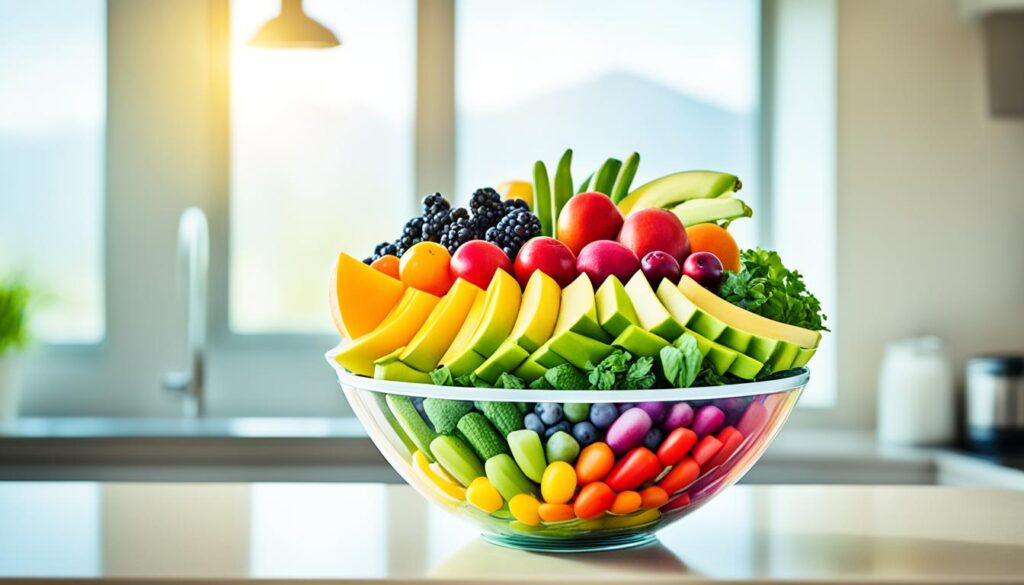
To illustrate the calorie density of different foods, below is a table comparing the calorie content of common raw foods with their processed equivalents:
Raw Food Calories per Serving Processed Food Calories per Serving Apple 52 Apple Pie 332 Carrot 41 Carrot Cake 235 Spinach 23 Spinach Dip 80 Almonds 163 Almond Butter 204
As you can see from the table, raw foods are generally lower in calories compared to their processed counterparts. This makes raw foods a great choice for weight loss, as you can enjoy larger quantities of food while consuming fewer calories.
It’s important to note that while the raw food diet can support weight loss, individual results may vary. It’s crucial to listen to your body and ensure you’re meeting your nutritional needs while on this diet. If you have any underlying health conditions or concerns, it’s always recommended to consult with a healthcare professional before making significant changes to your diet.
Raw Food Diet and Disease Prevention
When it comes to disease prevention, a raw food diet can be a powerful ally. By embracing the abundance of raw fruits and vegetables, you can provide your body with essential nutrients, antioxidants, and fiber, all of which contribute to overall health and help reduce the risk of chronic illnesses such as cancer, heart disease, and diabetes.
Raw fruits and vegetables are packed with nutrients that support the body’s natural defense mechanisms. The vibrant colors of these foods indicate the presence of antioxidants, which neutralize harmful free radicals and protect the cells from oxidative stress. Additionally, the fiber content in raw plants aids digestion, regulates blood sugar levels, and promotes satiety.
“A raw food diet allows me to nourish my body with the nutrients it needs to thrive and protect itself from disease.” – Grace Smith
By incorporating a variety of raw plants into your diet, you can ensure that you are providing your body with a wide range of essential nutrients. Leafy greens such as kale and spinach are rich in vitamins A, C, and K, as well as minerals like iron and calcium. Colorful berries offer a vibrant array of antioxidants, while cruciferous vegetables like broccoli and cauliflower provide cancer-fighting compounds.
Incorporating raw food into your daily meals doesn’t have to be complicated. Start by adding a raw salad or a green smoothie to your daily routine. Experiment with different fruits and vegetables, and enjoy the variety of flavors and textures that nature provides.
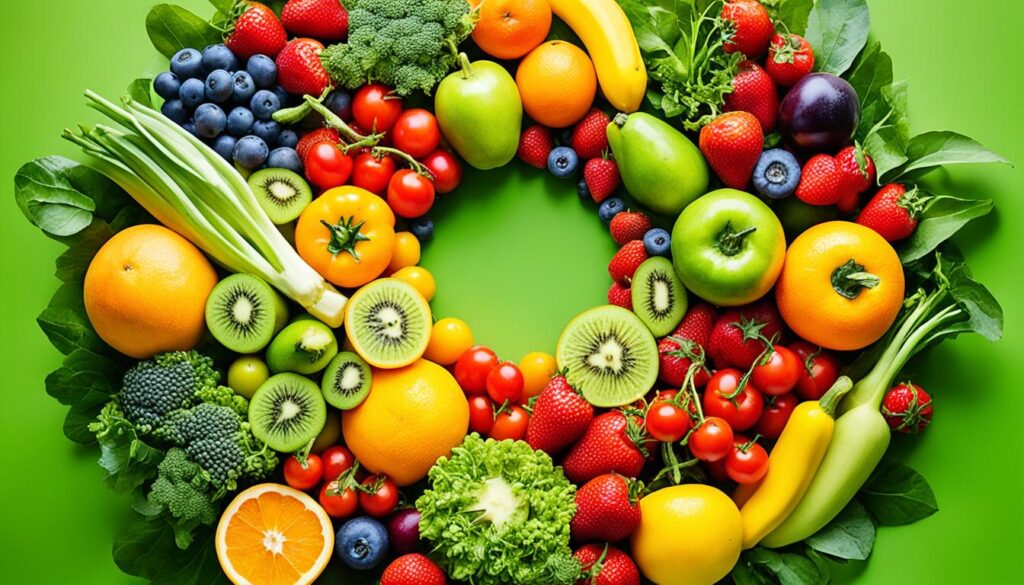
Benefits of a Raw Food Diet for Disease Prevention:
- Increased intake of essential nutrients
- Antioxidant protection against free radicals
- Regulation of blood sugar levels
- Promotion of digestive health
- Reduction in the risk of chronic diseases
A raw food diet can be a powerful tool in your journey towards optimal health and disease prevention. By nourishing your body with nature’s bounty, you can give yourself the best chance at a vibrant and disease-free life.
Raw Food Diet and Digestive Health
The raw food diet can have a positive impact on your digestive system, promoting optimal digestive health. One key element of this diet is its emphasis on raw fruits, vegetables, and sprouts, which are rich in fiber. Dietary fiber plays a crucial role in maintaining regularity and supporting a healthy digestive system. It adds bulk to the stool, making it easier to pass through the intestines, preventing constipation. By following a raw food diet, you can help ensure that your digestive system functions smoothly and efficiently.
Benefits of Fiber for Digestive Health
Dietary fiber is essential for maintaining a healthy digestive system. It aids in regulating bowel movements, preventing constipation, and promoting regularity. Additionally, fiber helps to keep you feeling full and satisfied after meals, reducing the likelihood of overeating and promoting weight management. Raw fruits, vegetables, and sprouts are excellent sources of fiber, providing your body with the necessary dietary fiber to support a healthy digestive system.
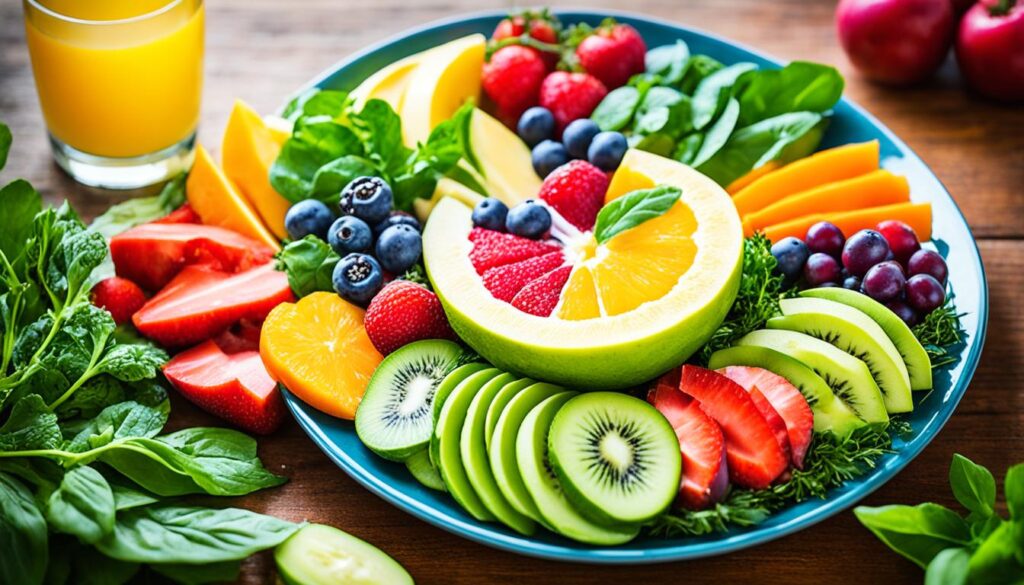
“Fiber is crucial for maintaining digestive health and promoting regularity.”
Enzymes and Gut Health
Another key aspect of the raw food diet is its inclusion of fruits, vegetables, and sprouts that contain natural enzymes. These enzymes help break down the food and facilitate the absorption of nutrients in the digestive system. By consuming raw foods, you provide your digestive system with an abundance of enzymes, making it easier for your body to digest and absorb nutrients. This aids in maintaining a healthy gut and optimizing overall digestive health.
“Raw foods contain beneficial enzymes that aid in digestion and nutrient absorption.”
Achieving Gut Health with a Raw Food Diet
By incorporating raw fruits, vegetables, and sprouts into your diet, you can support your gut health and promote a healthy digestive system. Aim to include a variety of raw plant foods in your meals, such as leafy greens, berries, citrus fruits, and cruciferous vegetables. These foods are not only rich in fiber and enzymes but also provide essential vitamins, minerals, and antioxidants. By prioritizing gut health through a raw food diet, you can experience improved digestion, increased nutrient absorption, and overall well-being.
Benefits of Raw Food Diet for Digestive Health Promotes regularity and prevents constipation Provides ample dietary fiber for optimal digestive function Offers natural enzymes for improved digestion and nutrient absorption Supports a healthy gut and overall digestive system
Raw Food Diet and Overall Well-being
Adopting a raw food diet can have a profound impact on your overall well-being. By embracing whole, plant-based foods, you nourish your body with an abundance of vitamins, minerals, and antioxidants that promote vitality and enhance your energy levels. Many individuals who follow a raw food diet report improved skin health, increased vitality, and a general sense of well-being. Prioritizing your health and well-being by incorporating raw, whole foods into your diet can transform your lifestyle and elevate your overall quality of life.
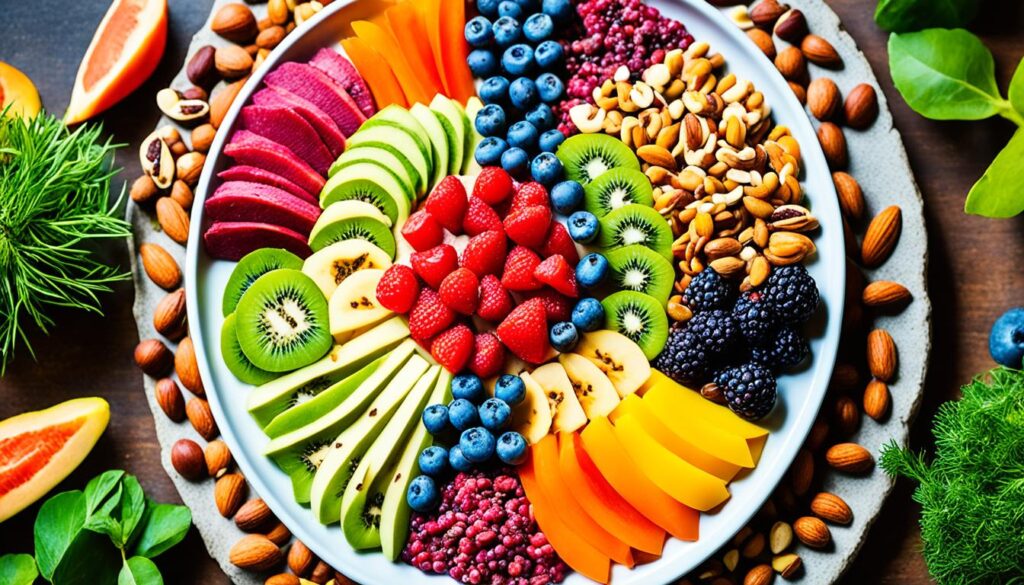
Raw foods, in their natural state, are packed with essential nutrients that support optimal health. By consuming a variety of fruits, vegetables, nuts, and seeds, you provide your body with the necessary building blocks for vitality and energy. The raw food diet, with its focus on whole, plant-based foods, offers a rich source of fiber, antioxidants, and phytochemicals that promote a healthy immune system and protect against chronic diseases.
One of the key benefits of adopting a raw food diet is the increased vitality and energy levels that many individuals experience. Raw foods are easily digestible and provide a steady release of energy throughout the day, eliminating the post-meal energy slumps often associated with heavy, cooked meals. By fueling your body with nutrient-dense foods, you can optimize your energy levels and maintain sustained vitality.
The raw food diet offers a natural approach to nourishment, promoting overall well-being and revitalizing your body with the power of whole, plant-based foods.
In addition to increased vitality and energy levels, those who follow a raw food diet often report improved skin health. Raw foods are rich in vitamins, minerals, and antioxidants that promote a healthy complexion and a natural, radiant glow. The abundance of hydration found in fruits and vegetables also plays a crucial role in maintaining skin elasticity and preventing dryness or dullness.
The Benefits of a Raw Food Diet at a Glance:
- Enhanced vitality and energy levels
- Improved skin health and a natural, radiant glow
- Increased intake of essential nutrients, vitamins, and minerals
- Enhanced immune function and disease prevention
- Support for a healthy weight management
By embarking on a raw food diet journey, you prioritize your well-being and tap into the transformative power of whole, plant-based foods. Embrace the vitality and energy that raw foods offer, and experience the numerous benefits of a natural, plant-based lifestyle.
Conclusion
The Ultimate 7-Day Raw Food Diet Plan is your gateway to a healthier and more vibrant life. By embracing the simplicity and nutrient-rich nature of raw foods, you can reset your palate, cleanse your body, and experience the multitude of benefits that come with a raw food diet. Throughout this 7-day journey, you’ll follow a carefully curated meal plan, indulge in delicious raw food recipes, and implement tips for success to ensure a seamless and fulfilling experience.
By adhering to this plan, you can enjoy the advantages of a raw food diet, such as improved digestion, increased energy levels, weight loss, and disease prevention. The abundant array of vitamins, minerals, antioxidants, and fiber found in raw, plant-based foods provide essential nourishment for your body and promote overall well-being. Whether you choose to fully commit to a raw food lifestyle or incorporate more raw foods into your current diet, this 7-day plan is an excellent starting point.
So why wait? Embark on this 7-day raw food challenge and unlock the incredible potential of a raw food diet. With each delicious meal and snack, you’ll be enhancing your health and harnessing the natural power of raw, vegan foods. Embrace the journey, savor each bite, and experience firsthand the transformative effects of nourishing your body with the finest that nature has to offer.
FAQ
What is a raw food diet?
What are the benefits of a raw food diet?
How do I get started on a raw food diet?
What does the 7-day raw food diet meal plan consist of?
Do you have any raw food diet recipes to share?
What tips do you have for success on a raw food diet?
Are there any risks associated with the raw food diet?
How does the raw food diet compare to a cooked food diet?
Can the raw food diet help with weight loss?
Can following a raw food diet help prevent diseases?
What impact does the raw food diet have on digestive health?
How does the raw food diet affect overall well-being?
With her ability to convey complex concepts in a clear and accessible manner, Belinda ensures that readers of all backgrounds can grasp the benefits and techniques of raw food. She excels at breaking down scientific information into digestible pieces, allowing readers to understand the impact of raw food on their bodies and encouraging them to make informed choices about their diet.
One of Belinda’s notable contributions to rachaelsrawfood.com is her collection of mouthwatering recipes. She delights in experimenting with various combinations of raw ingredients, exploring innovative ways to create delicious and nutritious meals. Belinda’s recipes showcase the incredible flavors and textures of raw food and emphasize its versatility, dispelling any misconception that a raw food diet is limited or monotonous.
In addition to her writing responsibilities, Belinda actively engages with the raw food community, attending workshops, seminars, and conferences to expand her knowledge and network. She enjoys connecting with like-minded individuals, exchanging ideas, and staying up to date with the latest trends and advancements in the field of raw food nutrition.
-

 Raw Food Ingredients2 months ago
Raw Food Ingredients2 months agoHow To Make Hot Chocolate With Raw Cacao Powder
-

 Raw Food Ingredients2 months ago
Raw Food Ingredients2 months agoHow To Make Chocolate From Raw Cacao
-

 What is Raw Food?2 weeks ago
What is Raw Food?2 weeks agoHow To Remove Raw Mustard Oil Smell From Cooked Food
-

 Raw Food Ingredients4 weeks ago
Raw Food Ingredients4 weeks agoRaw Cacao Powder How Much For 8 Oz Hot Chocolate Recipe
-
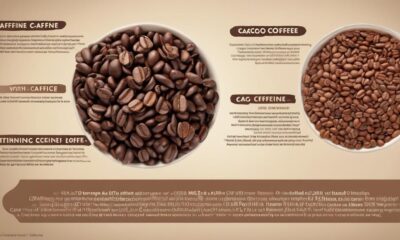
 Raw Food Ingredients4 weeks ago
Raw Food Ingredients4 weeks agoThe Truth Behind the Cacao Caffeine Myth
-

 Raw Food Ingredients2 months ago
Raw Food Ingredients2 months agoWhen Fasting Can I Drink Coffee With Raw Cacao Powder
-

 What is Raw Food?2 weeks ago
What is Raw Food?2 weeks agoHow To Store Raw And Cooked Food Separately
-

 Raw Food Ingredients2 months ago
Raw Food Ingredients2 months agoHow To Use Raw Cacao Beans




